

What Is a Prompt in Writing? (Ultimate Guide + 200 Examples)
Ever stumbled upon a blank page and didn’t know where to start?
That’s where a writing prompt steps in, kicking your creativity into gear and guiding your pen (or cursor) in the right direction.
What is a prompt in writing?
A prompt in writing is a starting point designed to ignite creativity, guiding writers to explore themes, genres, or emotions. It can be a word, question, image, or scenario, aiding in overcoming writer’s block.
Keep reading to learn everything you need to know about prompts in writing.
What Is a Prompt in Writing (Long Description)?

Table of Contents
A writing prompt is essentially a starting point.
Think of it as a spark designed to ignite your creativity and guide your thoughts in a specific direction.
This little nudge can come in various forms – a word, a sentence, a question, or even a picture – and serves the purpose of inspiring you to write.
Whether you’re drafting a story, an essay, or just jotting down your thoughts, prompts help overcome the intimidation of a blank page.
It sets a predefined theme or direction for your writing.
They’re not just about what you write, but how you think and approach writing, encouraging you to explore new ideas, genres, and perspectives.
Here is a good video that explains prompts in writing:
Types of Prompts in Writing
Now let’s go over different types of prompts in writing.
Common prompt types include:
The Story Starter
The question quest, picture this, the first line frenzy.
The Story Starter is your classic nudge towards narrative creativity.
It’s a sentence or scenario meant to kick off your storytelling journey, helping you dive straight into the plot, characters, or setting.
This type of prompt is great for fiction writers looking for a jumping-off point to explore various themes or genres.
It can be as detailed or as open-ended as you like, providing just enough information to spark an idea without dictating the direction of your story.
- “When the clock struck midnight, she realized…”
- “Lost in the forest, he stumbled upon a hidden village…”
- “The last person on Earth sat alone in a room. Suddenly, there was a knock at the door…”
- “In a world where magic is real, a young apprentice discovers…”
- “The photograph in the old book revealed a secret that would change everything…”
- “Stranded on a desert island, they found a message in a bottle…”
- “On her hundredth birthday, she received a letter that took her back to her youth…”
- “The map led them to a place that wasn’t supposed to exist…”
- “In the midst of war, a forbidden love blossomed…”
- “He inherited an old mansion, not knowing the ancestors would still be around…”
The Question Quest prompt type uses intriguing questions to push your thinking boundaries and explore ideas in depth.
It’s perfect for essays, reflective writing, or exploring complex themes and issues.
These prompts challenge you to consider different perspectives, analyze situations, and develop reasoned arguments or narratives based on the question posed.
- “What would you do if you could travel back in time?”
- “How would society change if humans lived to be 300 years old?”
- “Is it possible to live a completely ethical life in today’s world?”
- “What does true bravery look like?”
- “How would the discovery of extraterrestrial life impact humanity?”
- “What is the true cost of progress?”
- “Can happiness be measured?”
- “What role does fate play in our lives?”
- “Is technology bringing us closer together or driving us apart?”
- “What would you change if you were the leader of your country for a day?”
Picture This prompts use images as the springboard for writing.
A photograph, painting, or even a random doodle can unlock a flood of creativity.
Which makes it an excellent tool for both fiction and non-fiction writers.
This visual cue encourages you to dive into descriptive writing, storytelling, or even analytical essays, exploring the emotions, stories, or ideas evoked by the image.
- A deserted street at dawn, with an old bicycle leaning against a lamppost.
- A vintage suitcase, open and filled with letters and photographs.
- A bustling market scene in a foreign country.
- A child gazing out of a rain-spattered window.
- A majestic mountain range under the stars.
- An abandoned house, its rooms still furnished but covered in dust.
- A close-up of a spider web with dewdrops.
- A lively street festival, with people dancing and musicians playing.
- An old, faded map with several places marked in red.
- A serene lake at sunset, with a lone boat tied to a wooden dock.
The First Line Frenzy is a thrilling way to dive into a story.
These prompts provide the opening sentence of your narrative, setting the tone and direction for everything that follows.
It’s a fantastic method for overcoming writer’s block and sparking your imagination, as the initial line can lead to unexpected and exciting story developments.
- “The day began with a mysterious package on my doorstep.”
- “I never believed in ghosts until I moved into the old Henderson house.”
- “The moment I heard the news, I knew my life would never be the same.”
- “Under the light of a full moon, the city revealed its true secrets.”
- “It was the kind of café you’d stumble upon once and never find again.”
- “With a deep breath, I stepped into the unknown.”
- “The letter, sealed with a wax emblem, contained a proposition I couldn’t refuse.”
- “As the train pulled away, she realized her mistake.”
- “In the heart of the ancient forest, a hidden path led to unexpected wonders.”
- “The discovery promised to rewrite history, but at what cost?”
Dialogue Driven
Dialogue Driven prompts center around a snippet of conversation, offering a dynamic entry point into your writing.
This approach is particularly effective for character development and exploring relationships through direct speech.
It can set the scene, reveal personalities, and drive the plot forward, all through the power of dialogue.
- “Did you really think I wouldn’t find out?” “I was hoping.”
- “Why is this door always locked?” “You’re not ready to know what’s behind it.”
- “Just because you can, doesn’t mean you should.” “That’s where you’re wrong.”
- “The stars look different here.” “Everything does.”
- “I wish I could stay.” “Then why are you leaving?”
- “It’s not about what I want anymore.” “Then what’s it about?”
- “I’ve never seen anything like it.” “And you never will again.”
- “Can you keep a secret?” “Depends on the secret.”
- “We’re not in Kansas anymore.” “We’re not even on the same planet.”
- “It was supposed to be a simple plan.” “Since when does anything go according to plan?”
The Sensory Dive
The Sensory Dive prompts are designed to immerse you and your reader in vivid, sensory-rich experiences.
These prompts encourage descriptive writing that appeals to the senses, painting a scene so tangible that readers feel they can touch, taste, hear, see, and smell it.
It’s a powerful tool for creating immersive worlds and experiences.
- Describe the cacophony of a bustling city market at noon.
- The taste of the first snowflake of winter.
- The scent of old books in a forgotten library.
- The feeling of sand between your toes as waves crash on the shore.
- The sight of a landscape transformed by autumn’s touch.
- The sound of a distant thunderstorm approaching.
- The warmth of a crackling fire on a cold night.
- The chill of walking through a foggy graveyard at dusk.
- The texture of an ancient, carved stone.
- The silence of a snow-covered forest.
The What-If Wonder
The What-If Wonder prompts take you on a journey of imagination, exploring alternate realities and scenarios.
These prompts ask you to consider how different choices, events, or conditions might alter the world, characters, or story.
It’s an excellent way to delve into speculative fiction, science fiction, and fantasy, pushing the boundaries of reality.
- What if humans had the ability to communicate telepathically?
- What if gravity suddenly became a variable force on Earth?
- What if you woke up 100 years in the past with your current memories intact?
- What if plants were the dominant intelligent species on the planet?
- What if you could see the future but only 24 hours ahead?
- What if water was as rare as gold?
- What if everyone had their lifespan displayed above their heads?
- What if you found a door that could take you to parallel universes?
- What if animals could petition for their rights?
- What if dreams were actually glimpses into alternate realities?
The Emotional Rollercoaster
The Emotional Rollercoaster prompt is all about exploring the depths of human emotion, challenging you to convey complex feelings and reactions.
These prompts are perfect for delving into character development, interpersonal relationships, and personal reflection.
By focusing on the emotional landscape, writers can create compelling narratives that resonate with readers on a deeply personal level.
- The moment you realized you were in love.
- Feeling utterly lost in a place you once called home.
- The bitter sweetness of a farewell.
- Overcoming a fear that once held you back.
- The complex emotions of reuniting with someone after many years.
- The guilt of a lie that spiraled out of control.
- The rush of achieving something you thought was impossible.
- The profound sadness of losing a cherished memory to time.
- The unexpected joy found in a simple act of kindness.
- The peace of accepting things you cannot change.
The Genre Blender
The Genre Blender prompts encourage you to mix elements from different genres, creating unique and innovative narratives.
These prompts are excellent for writers looking to break the mold and experiment with their storytelling.
Whether it’s combining science fiction with historical fiction or fantasy with mystery, the possibilities are endless.
- A detective in a dystopian future solving a crime that could change the course of history.
- A romance blossoming in the midst of a zombie apocalypse.
- A fantasy world where magic is dying, and technology is on the rise.
- A historical drama set in ancient Rome, but with a twist of time travel.
- A horror story set in space, aboard a ship with a mysterious alien artifact.
- A western where the frontier towns are protected by wizards instead of gunslingers.
- A cyberpunk thriller featuring a heist in a virtual reality world.
- A mystery set in a magical school where the students must uncover a dark secret.
- A superhero story grounded in the real-world challenges of modern society.
- An adventure tale that blends deep-sea exploration with ancient mythology.
The Time Traveler’s Gateway
The Time Traveler’s Gateway prompts explore the intricacies of time travel, its implications, and its paradoxes.
This type of prompt is perfect for science fiction and speculative fiction writers, offering a playground for the imagination that challenges our understanding of time, history, and causality.
- Discovering a time machine in your backyard and deciding where to go first.
- A message from the future warning of an impending disaster.
- The consequences of changing a small event in the past.
- A society where time travel is common, but strictly regulated.
- An ancient civilization that had advanced time travel technology.
- Meeting your ancestors and learning their secrets.
- The ethical dilemmas of using time travel for personal gain.
- A love story that transcends time barriers.
- The discovery that history is a construct, shaped by time travelers.
- A time loop where the protagonist must solve a puzzle to escape.
The World Builder’s Dream
The World Builder’s Dream prompts invite you to create entire worlds from scratch.
This type of prompt is a boon for fantasy and science fiction writers, offering the freedom to craft unique settings, cultures, laws of nature, and societies.
It’s an opportunity to let your imagination run wild and establish the groundwork for epic tales.
- A planet where the seasons last for decades.
- A city built entirely on the back of a giant, wandering creature.
- A society where people’s roles are determined by their innate magical abilities.
- An underwater civilization that has never seen the surface.
- A world where dreams can be entered and manipulated.
- A floating island nation that travels the skies.
- A dystopian future where memories can be bought and sold.
- A kingdom where music is the source of all magic.
- A realm where the night lasts half the year.
- An alternate Earth where the continents never split apart.
The Unseen Perspective
The Unseen Perspective prompts challenge you to write from the viewpoint of non-human characters or entities.
This approach forces you to step outside the human experience and consider the world from a completely different angle.
It’s a fantastic way to explore themes of consciousness, nature, and the interconnectedness of life.
- The life of a tree over centuries, witnessing the changes in the world.
- A day in the life of a household pet during a major family event.
- The thoughts of a spaceship AI as it travels through the cosmos.
- The experiences of a ghost haunting an old mansion.
- A story told from the perspective of a river, from source to sea.
- The journey of a single leaf from sprout to falling to the ground.
- The collective consciousness of a hive of bees facing environmental challenges.
- The ancient spirit of a mountain overseeing its surroundings.
- The adventures of a book as it passes from reader to reader, experiencing different interpretations and emotions.
- The perspective of a city as it grows and evolves over centuries, through peace and conflict.
The Emotional Journey
The Emotional Journey prompts focus on the internal growth and transformation of characters.
It invites writers to delve into personal development, self-discovery, and the overcoming of obstacles.
This type of prompt is ideal for character-driven narratives, where the emphasis is on emotional depth and the evolution of the protagonist’s inner self.
- A character grappling with the loss of a loved one and finding a way to move forward.
- The journey of self-acceptance for someone who feels out of place in their world.
- A hero facing their darkest fears in order to save what they cherish most.
- A villain’s realization of the impact of their actions and their quest for redemption.
- A young adult’s transition into independence and the challenges they face along the way.
- The transformation of a skeptic into a believer through a series of unexplainable events.
- The struggle of a character to forgive themselves and others for past mistakes.
- The process of rebuilding one’s life after a catastrophic event.
- A character’s journey from indifference to passionate advocacy for a cause.
- The evolving relationship between two characters who start as rivals and become allies.
The Moral Dilemma
The Moral Dilemma prompts put characters in situations where they must make difficult choices, often between two equally undesirable options.
These prompts are great for exploring ethical questions, character morality, and the complexity of human nature.
They challenge writers to think deeply about what it means to make a “right” decision.
- Choosing between saving a loved one or a group of strangers from danger.
- Deciding whether to expose a painful truth that could destroy a friend’s happiness.
- The choice of upholding the law or doing what is morally right in a corrupt society.
- A character must decide whether to seek revenge or forgive an unforgivable act.
- The dilemma of sacrificing personal dreams for the greater good.
- Deciding whether to keep a secret that protects one person but harms others.
- A leader’s choice between peace at the cost of justice or war for the sake of freedom.
- The ethical implications of using advanced technology to alter human nature.
- A scientist faces a moral conflict over a discovery that could change the world but has dangerous implications.
- The struggle of a character who finds out that their entire life is based on a lie and must choose how to react.
The Creative Challenge
The Creative Challenge prompts are designed to push the boundaries of conventional storytelling.
It encourages experimentation with narrative structure, style, and content.
These prompts invite writers to play with unconventional formats, such as a story told in reverse, a narrative composed entirely of dialogue, or a tale that weaves multiple perspectives into a cohesive whole.
- A story told through a series of diary entries, each revealing a piece of the puzzle.
- A narrative structured as a series of text messages between characters.
- A tale that begins with its conclusion and works backward to the start.
- A story where each chapter is from the perspective of a different character, all revolving around a single event.
- A narrative composed entirely of letters sent between two characters.
- A story told through the lens of an inanimate object witnessing events unfold.
- A tale that intertwines the past and present, revealing how they mirror and affect each other.
- A narrative that challenges the concept of linear time, mixing moments from various points in the characters’ lives.
- A story where the setting changes in each chapter, influencing the plot and characters in unique ways.
- A narrative that plays with genre conventions, blending elements from different genres in unexpected ways.
Final Thoughts: What Is a Prompt in Writing?
I hope this guide “prompts” you to understanding, creativity, and motivation to write.
Check out some of our other great guides below.
Read This Next:
- What Is A Personal Account In Writing? (47 Examples)
- 150+ Christmas Story Ideas, Tips & Prompts (Fun & Festive)
- 620 Best ChatGPT Prompts for Writing a Nonfiction Book
- 650+ Best Prompts for ChatGPT (Ultimate List for 2024)
- 346 Fluff Prompts (Easy & Unique)
Ivana Vidakovic
Sep 30, 2023
How To Create A Writing Prompt - Step-by-Step Guide
Learn how to create engaging writing prompts and discover expert tips and techniques in our comprehensive guide for your next writing adventure.

TABLE OF CONTENTS
Ever since the whole ChatGPT craze took off, everyone's been talking about one thing – prompts.
It turns out, nailing the right prompt is the secret sauce for having a great chat with AI.
Nevertheless, writing prompts have a history that started long before the AI tools came around.
So, we thought, why not explain what writing prompts are the types that exist, and help you whip up the best ones for your writing?
So, grab your cup of coffee, kick back, and let's dive into the beautiful world of prompts!
What is a Writing Prompt?
A writing prompt is a specific topic, idea, phrase, or question provided to writers as a creative starting point to inspire them and stimulate their writing.
Writing prompts are commonly used in various writing exercises, workshops, and creative writing classes to help writers overcome writer's block, generate new ideas, or simply get their creative juices flowing .
6 Types of Writing Prompts With Examples
The goal of a writing prompt is to encourage writers to think creatively, develop their writing skills, and produce original content .
The same goes for conversations with AI tools — the more straightforward the prompt, the more precise the answer you’ll get.
Furthermore, prompts can be particularly useful for individuals who are looking for ideas to write about , whether they are seasoned writers or beginners.
1. Single Words or Phrases
A writing prompt can be a single word (e.g., " candle ," " freedom ") or a short phrase (e.g., " lost in the woods ," " a secret revealed ") to build writing around.
📝Prompt: Eclipse
💡Writing Idea: Write a poem that captures the beauty and mystery of a solar eclipse.
2. Questions
Thought-provoking questions can be used to spark introspective or imaginative writing.
📝Prompt: What would you do if you could become invisible for a day?
💡Writing Idea: Craft a short story describing the adventures and moral dilemmas of a person who discovers the power of invisibility.
3. Images or Visual Prompts
Sometimes, a picture, painting, or photograph is provided as a prompt, and writers are asked to describe, interpret, or expand upon what they see.
📝Prompt: Show an image of an old, abandoned library with dust-covered books and cobwebs.
💡Writing Idea: Write a descriptive essay about the history and stories hidden within the abandoned library and the person who stumbles upon it.
4. Scenarios or Situations
Writers might be given a scenario or situation to explore , such as:
- " Write a story from the perspective of a character who just won the lottery ", or
- " Describe a conversation between two people meeting for the first time ."
📝Prompt: Write a dialogue between a young detective and an eccentric inventor who claims to have built a time machine.
💡Writing Idea: Create a dialogue that reveals the detective's skepticism and the inventor's earnest conviction about the time machine's capabilities.
5. Quotes or Excerpts
A quote from a famous author, philosopher, or historical figure can be used as a starting point for reflection or creative writing.
📝Prompt: "In three words I can sum up everything I've learned about life: it goes on." - Robert Frost
💡Writing Idea: Write a reflective essay on the meaning of this quote and how it relates to your own experiences .
6. Randomly Generated Words or Elements
Some prompts are generated randomly , such as generating 3 random words and asking writers to create a story or poem that incorporates them.
📝Prompt: Generate 3 random words - "Dragon," "Ice Cream," "Whisper."
💡Writing Idea: Craft a short story that involves a dragon who secretly enjoys eating ice cream and the child who discovers this unusual secret .
It's important to note that the examples we've provided as "writing ideas" can also serve as prompts.
In fact, anything that provides you with a focal point to steer your writing is essentially a writing prompt.
Now, let’s find out how to create a writing prompt on your own.
How to Create a Writing Prompt?
1. define your purpose.
Determine the purpose of your writing prompt.
Are you trying to spark creativity, inspire self-reflection, or generate a specific type of content?
If you define the goal of your content, it can help you create a more effective prompt.
2. Choose a Type of Prompt
Decide what type of writing prompt you want to create.
As mentioned previously, you can choose from single words, phrases, questions, images, scenarios, quotes, or random elements.
3. Consider Your Audience
Think about the intended audience for your writing prompt.
Are you creating it for yourself, a specific group of writers, or a more general audience?
Tailor the prompt to suit the needs and interests of your audience.
4. Be Clear and Concise
Keep your writing prompt clear and concise .
Avoid unnecessary complexity or ambiguity. A good prompt should provide enough direction to start but leave room for creativity.
5. Make It Thought-Provoking
The best prompts often challenge writers to think deeply or consider unusual perspectives . Thought-provoking prompts can lead to more engaging and creative responses.
6. Incorporate Specific Details
If your prompt includes specific details , it can help to set the scene or context for the writing.
For example, describe what's in the image if you're using an image prompt.
If it's a scenario prompt, provide relevant details about the situation.
7. Avoid Biased Language
Ensure your prompt doesn't impose your personal beliefs or values on the writer.
Prompts should be open-ended and inclusive.
8. Test Your Prompt
Before sharing your prompt with others, test it by writing a sample response yourself.
This can help you identify any issues or ambiguities in the prompt.
Write Your Prompts With TextCortex
TextCortex is your ultimate solution for crafting writing prompts and generating high-quality content effortlessly.
This AI-powered assistant is here to supercharge your writing tasks without sacrificing content excellence.
With TextCortex, you can efficiently tackle multiple writing challenges, ensuring you create engaging prompts with ease.
Here's how TextCortex can transform your writing experience:
🔗 User-Friendly — Access TextCortex through a web application or a handy Chrome extension , ensuring user-friendliness and accessibility.
🛠️ Versatile Assistance — TextCortex is designed to cater to all your text-related needs, making it the ideal tool for generating compelling writing prompts.
🧩 Seamless Integration — Our browser extension seamlessly blends with over 4000 webpages and apps , providing support whenever and wherever you need it.
✍️ Abondance of Writing Features — In addition to its conversational ZenoChat , TextCortex offers templates , a rewriting tool with 10+ functionalities, the ability to set up your unique writing persona, and much more.
🌍 Multilingual Support — TextCortex is proficient in generating text in over 25 languages, making it a global solution for crafting captivating writing prompts.
Watch our video to see it in action!
Interested to try it yourself?
Sign up now to experience the magic of TextCortex and revolutionize your content creation process.🧑🚀
Reimagine the way you interact with AI.
Harness knowledge with an AI of your own, define behaviour and integrate your favorite tech stack on over 30,000 platforms.
Did you like this article? Explore a few more related posts.

12 UX Writing Best Practices You Should Know

7 Best Practices for Writing Policies and Procedures

9 Best Practices for Writing User Stories
Questions answers..
TextCortex is a powerful AI-powered writing tool that can help you reduce your writing time, handle big tasks, and create high-quality content without errors. With its customizable platform, personalized intelligence experience, advanced writing and research capabilities, and error-free content, TextCortex is the perfect tool for creative professionals who want to be a creative force in their industry.
Our AI copilot learned how to write from more than 3 billion sentences and has the ability to create unique content. However, fact-checking is something which still requires a human approval.
TextCortex supports more than 25 languages including English, Dutch, German, Ukranian, Romanian, Spanish, Portuguese, French, Italian.
Yes, TextCortex is completely free to use with all of its features. When you sign up, you receive 100 free creations. Then you will receive 20 recurring creations every day on the free plan.
Yes, we have a Text Generation API, please talk to us directly to implement it. You can reach out to us at [email protected]
Account sharing is not allowed. If you have a need for more than 5 seats for an account, you can directly contact us at [email protected]
Yes, TextCortex offers 14-day free trial for users to try out all features extensively with higher number of generations. But keep in mind that you can already try everything with the free plan. There is no feature that is locked behind a premium plan.
Overall, TextCortex AI has over 1000 five-star reviews on reputable review sites such as G2, Trustpilot and Capterra.
TextCortex learns and adapts to your unique writing style and knowledge, making it easier for you to write high-quality & personalized content.
Your premium features will be available until the end of your subscription date, then your account plan will be set to Free plan.
General Questions
Your ai copilot is ready to collaborate with you..
Connect your knowledge, customize the style and start collaborating with your AI copilot.

Want to create or adapt books like this? Learn more about how Pressbooks supports open publishing practices.
IV. Tips for Writing Prompts
Writing prompts: the instructions.
A writing prompt in WRIT will ask you to consider the same set of questions each week. The prompt instructions remind you that there are three very important components that should be included in your response for optimal success. Below are the standard prompt instructions that you’ll see each week in WRIT:
Your Task: compose a critical response essay—including, ideally, an introduction, at least three body paragraphs, and a conclusion—to the text below
Goals: your essay should include the following:
- A brief summary of the author’s argument
- mostly agree with the author and provide your own persuasive assertions that extend support for the author’s position
- mostly disagree with the author and provide your own persuasive assertions that defend your counter-position
- Your refutation of at least one objection a reader might have to your argument (or any point therein)
Failing to address each of these goals will significantly reduce your ability to respond appropriately and completely to the prompt. Don’t worry, though! In WRIT, you’ll learn how to respond to each of the requirements listed in the instructions above; it will just take a bit of time and practice.
Prompt Writing Guide
When you study a writing prompt closely and use it as the basis for your outline, you will be better equipped to address the goals of your own response. It’s important to do the following when reading and responding to a prompt:

Putting the Pieces Together Copyright © 2020 by Andrew M. Stracuzzi and André Cormier is licensed under a Creative Commons Attribution-NonCommercial-ShareAlike 4.0 International License , except where otherwise noted.
Share This Book
How to Create a Writing Prompt: Step-by-Step
Learn how to create a writing prompt that works using step-by-step in our guide.
Writer’s block can be a serious problem for many writers. Even the best writing has to come from somewhere, and when you are struggling to get started, you will feel frustrated. Learning how to create a writing prompt will help you get your creative writing ideas flowing, so you can get past your writer’s block and start writing engaging, effective content.
If you find it challenging to start writing while staring at a blank page, this guide will teach you how to create a writing prompt that will help. Whether you’re writing an essay or a short story, use these steps to generate creative writing prompts .
Step 1: Try Free Writing
Step 2: expand on an idea, step 3: change the point of view, step 4: start with a quote, step 5: explore your favorite place, step 6: use images or objects, step 7: choose a generic writing prompt, step 8: use your writing prompt.

If you’re stuck, consider some free writing. Grab a piece of paper and write down anything that comes to your mind. As you brainstorm, you will see your creative juices start flowing.
Perhaps the first thing that comes to mind is a funny story about a family member from last Christmas, or maybe it’s an expository essay you just read on a political topic. Just write it down and write down as many thoughts on that topic as you can, and you might pull a writing prompt from the mix. Don’t know how to copyright your book? Check out our guide on how to copyright a book . You can also check out our other how-to articles by typing “how to” in our search bar.
After brainstorming, look at your list. Does any particular idea stand out? Ask questions about that idea to expand on it.
One of the best ways to do this is to ask “what if” questions. With your idea, ask “what if” something happened a different way. This will help you generate your own writing prompts just from the ideas already in your head. Stuck? Read our list of brainstorming tips .
If you have a writing idea from a particular fairy tale or book, consider changing the point of view. Could you tell the story of Sleeping Beauty but from the evil queen’s point of view?
This writing exercise works for middle school and high school students and adults, and it often comes up with some interesting finished products. By changing the point of view, you can look at a well-known story in a completely different light. Learn more about first versus third person

Maybe you don’t have a fleshed-out idea to use. Instead, take a favorite quote and use it as the first line of your essay or story. Let your writing skills shine as you take that quote and turn it into something interesting.
This option can be a great way to create persuasive writing prompts. Grab a list of quotes designed to persuade, and transform them into something great. Check out our quotes about writing .
If you are still stuck, consider writing about your favorite place or a place you go regularly, like the grocery store. Use all of your sensory words to describe this place. Talk about what you hear, see, smell, feel and even taste while you walk through it.
This type of real-life writing can be very powerful, and it can be a great story starter. Give the writer the prompt to explore their favorite place, then write a narrative or expository essay that involves that place. The opportunities for creativity are endless. If you are just starting your writing career you might find our guide on how to write a personal essay helpful to kickstart your journey! You can also check out our other how-to articles by typing “how to” in our search bar.
Instead of using words, consider making a writing prompt out of an image or even an object. Collect images, old postcards or physical objects, and present these as the prompt.
The key to this type of writing is to create a story or essay about that object. It requires imaginative thinking to determine where the object came from and what it might have meant. You can take this a step further by blindfolding the writers and asking them to experience the object using their other senses, then put the object away and let them write.
Sometimes, a one-line, generic writing prompt is all you need to start generating ideas. Some thoughts include:
- I want to…
- I know that…
- What I fail to notice is…
- I wonder…
- I am looking for…
These options are great for personal writing, as they ask the writer to dig into their own ideas and thoughts.
Now that you’ve explored some ideas, you are ready to start creating the prompt . Keep it short, simple, and open-ended. The goal is to provide yourself or a writing group with an idea they can expand on for their writing time.
The length of a good prompt varies. You can keep it very short, one sentence or opening phrase, or provide the foundation for a story that the writer expounds upon. The key is to leave enough to the imagination that the writer can express themselves more easily.
20+ Narrative Essay Prompts
by Sue Weems | 0 comments
Start Your Story TODAY! We’re teaching a new LIVE workshop this week to help you start your next book. Learn more and sign up here.
If you're practicing your personal essay skills or just storytelling in general, these narrative essay prompts are a great way to get started!
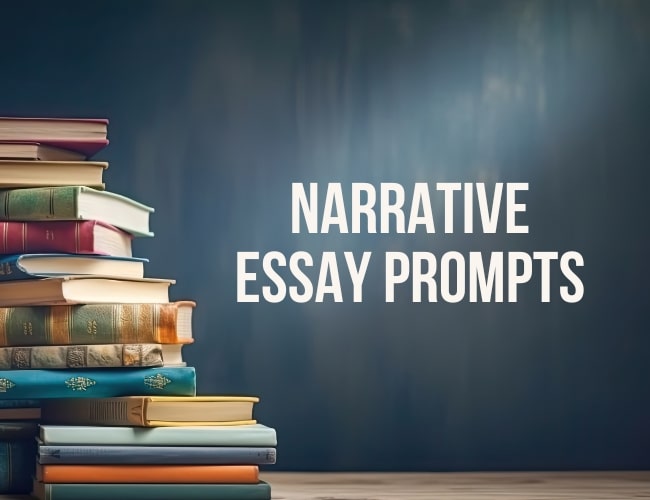
What is narrative writing?
Narrative essays are a unique form of writing that allows authors to tell their personal stories, weaving personal experiences into a cohesive and engaging format. Unlike traditional essays that focus on analysis or argumentation, narrative essays emphasize storytelling, often emphasizing emotions, character development, and vivid imagery. The aim is to transport readers into the writer's world, offering them insights into personal beliefs, values, or lessons learned through real-life situations.
At the heart of a narrative essay is a central theme or message that resonates throughout the narrative. This theme serves as a guiding thread, connecting various events, emotions, and characters.
In this article, we'll explore various narrative essay ideas designed to spark creativity and inspire writers to delve into their experiences. Whether you're a student looking for a writing assignment or a seasoned writer seeking new material, these prompts will help ignite your imagination and shape compelling narratives.
If you're looking for a step-by-step guide on how to write a personal narrative essay , check out our comprehensive guide here .
Narrative Essay Prompts
- Describe a time when a seemingly trivial decision led to an unexpected adventure that changed your perspective on life.
- Write about the moment you realized that you had become just like one of your parents, and how it made you feel.
- Reflect on a mistake you made that spiraled into a series of fortunate events, ultimately leading to a significant life lesson.
- Tell the story of someone who lost their home (or something of value) but found a new sense of community and belonging in an unexpected place.
- What major event has changed your life more than any other? Write an essay describing the event and what it changed.
- Write about a time you or someone you know had to make a difficult decision.
- Revisit a passion or hobby you abandoned long ago, detailing the emotions and memories that surfaced upon your return.
- Share the experience of a family gathering that revealed surprising secrets and strengthened your bonds with relatives.
- Write about a time you stood up for someone else, and how it impacted your understanding of bravery and justice.
- Describe an encounter with a stranger that taught you something profound about compassion and human connection.
- Reflect on a cherished recipe passed down through generations, and the memories it evokes each time you prepare it.
- Write about a family road trip or a family vacation that was a memorable experience.
- Tell the story of facing a fear that had haunted you for years, and how overcoming it transformed your self-image.
- Write a narrative about receiving a phone call that brings unexpected news. Capture the emotions you experience and how you respond to the information, whether it’s good or bad.
- Narrate a day when everything seems to go wrong—from waking up late to losing something important. Use humor and creativity to depict the mishaps and how you ultimately find a way to turn the day around.
- Write about a time someone taught you something difficult and taught you a valuable lesson.
- Tell about a time you made something whether a cake, birdhouse, song, story, or something else.
- Write about a place you go that feels like a second home.
- Write about a time you volunteered or helped someone else in a significant way.
- What is something you and your family or friends do that is unique to you or your culture?
- Tell about a time you visited somewhere new and learned something about yourself or the world.
- Write about a gift that changed your perception of something.
- Tell about an experience with music or art that shifted your understanding or gave you a deeper appreciation.
These prompts encourage students to tap into their imagination and life experiences, making narrative writing both fun and meaningful!
Choose one of these ideas and write for fifteen minutes . When you're finished, share your story in the Pro Practice Workshop for feedback from the community. And if you share, please be sure to comment on a few stories by other writers.
Sue Weems is a writer, teacher, and traveler with an advanced degree in (mostly fictional) revenge. When she’s not rationalizing her love for parentheses (and dramatic asides), she follows a sailor around the globe with their four children, two dogs, and an impossibly tall stack of books to read. You can read more of her writing tips on her website .
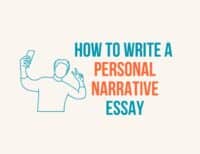
Work with Sue Weems?
Award-winning instructor and writer of 20+ years, book coach, and editor. Sue Weems specializes in working with Children's, Memoir, Middle Grade, Mystery, Nonfiction, Romance, and Thriller books. Sound like a good fit for you?
Submit a Comment Cancel reply
Your email address will not be published. Required fields are marked *
Submit Comment
Join over 450,000 readers who are saying YES to practice. You’ll also get a free copy of our eBook 14 Prompts :
Popular Resources
Best Resources for Writers Book Writing Tips & Guides Creativity & Inspiration Tips Writing Prompts Grammar & Vocab Resources Best Book Writing Software ProWritingAid Review Writing Teacher Resources Publisher Rocket Review Scrivener Review Gifts for Writers
Books By Our Writers

You've got it! Just us where to send your guide.
Enter your email to get our free 10-step guide to becoming a writer.
You've got it! Just us where to send your book.
Enter your first name and email to get our free book, 14 Prompts.
Want to Get Published?
Enter your email to get our free interactive checklist to writing and publishing a book.
Pennington Publishing Blog
- Grammar/Mechanics
- Literacy Centers
- Spelling/Vocabulary
- Study Skills
- Uncategorized
How to Write an Effective Essay Prompt

How to Dissect an Essay Writing Prompt
Writing an effective essay prompt requires equal shares of art and science. The prompt must allow room for creative interpretation and analysis. However, the prompt must also provide organization and boundaries for the writers’ responses. Finally, the prompt should provide ample room for post-writing criticism to help students improve their writing.
Writing Prompt Guidelines
1. The prompt should be brief. Wordiness only serves to confuse the writer.
2. The prompt should be focused. A prompt that rambles in an attempt to explain or motivate is counter-productive.
3. The prompt should require only the prior knowledge that has been emphasized in class instruction. Isolate the variables of personal experience to best assess the outcomes of instruction.
4. The prompt should be age appropriate. Know the developmental capabilities and interests of your students and translate these into the writing prompt.
5. The prompt should avoid issues which students or parents would find objectionable. Save the PG-13 issues for older students. Don’t let the subject interfere with the writing task.
6. The prompt should not be so personal that the privacy of the writer is jeopardized. A writing prompt should not inhibit the writer from answering honestly and comfortably.
7. The prompt should not embarrass the gender, ethnicity, or socio-economic background of the writer. Stay sensitive to these variables within your classroom. Words have different meanings according to one’s perspective.
8. The prompt should allow students of varying abilities to respond effectively. An ideal prompt allows all students to experience success in their writing.
9. The prompt should be interesting enough to motivate the writer. A prompt that does not provoke thought will reap a thoughtless response.
10. The prompt should allow “room to breathe” for divergent thinkers. Expect the unexpected in student responses, and design prompts to allow for a variety of responses.
11. The prompt should enable the writer to respond with a thesis that states the purpose of the writing and/or the author’s point of view (claim or argument). If you can’t turn the writing prompt into a thesis statement without effort, your students will never accomplish this task.
12. The prompt should not artificially force the writer into a certain thesis. A one-sided prompt that demands a certain thesis will not produce original thought.
13. The prompt can provide a writing situation to set the writing directions in context. However, the writing situation should not overwhelm or confuse the writing instructions.
14. The prompt should have clear writing instructions. Writers are the best judges as to whether the prompt has clear instructions. Avoid vocabulary and terms that will confuse the students. Don’t use writing direction words, such as “analyze”, if your students do not understand them.
15. The prompt should be one that will afford your writers plenty of evidence with which to prove or elaborate upon their topic sentences. Picking narrow or obscure writing subjects will not allow your writers to weigh easily accessible evidence. They will also be tempted to plagiarize or invent when little evidence is available.
16. The prompt should be able to be boiled down into a question to be answered. That answer will be the thesis statement.
Writing directions words for essays designed to inform the reader…
1. Describe means to show the characteristics of the subject to the reader through visual details.
2. Explain means to make something clear or easy to understand.
3. Discuss means to talk about all sides of the subject.
4. Compare means to show how things are the same, and contrast means to show how things are different. If the writing prompt only mentions compare, you must still do both tasks.
Writing directions words for essays designed to convince the reader…
5. Analyze means to break apart the subject and explain each part.
6. Persuade means to convince the reader of your argument or claim.
7. Justify means to give reasons, based upon established rules, to support your arguments.
8. Evaluate means to make a judgment about the good and bad points of the subject.

TEACHING ESSAYS BUNDLE
The author’s TEACHING ESSAYS BUNDLE includes the three printable and digital resources students need to master the CCSS W.1 argumentative and W.2 informational/explanatory essays. Each no-prep resource allows students to work at their own paces via mastery learning. How to Teach Essays includes 42 skill-based essay strategy worksheets (fillable PDFs and 62 Google slides), beginning with simple 3-word paragraphs and proceeding step-by-step to complex multi-paragraph essays. One skill builds upon another. The Essay Skills Worksheets include 97 worksheets (printables and 97 Google slides) to help teachers differentiate writing instruction with both remedial and advanced writing skills. The Eight Writing Process Essays (printables and 170 Google slides) each feature an on-demand diagnostic essay assessment, writing prompt with connected reading, brainstorming, graphic organizer, response, revision, and editing activities. Plus, each essay includes a detailed analytical (not holistic) rubric for assessment-based learning.
Literacy Centers , Study Skills , Writing essay , essay strategies , Mark Pennington , Teaching Essay Strategies , teaching writing , writing style
Links to Programs and Resources
- About the Author/Contact Us
- Free Reading/ELA Assessments
- Free Articles and Resources
- Testimonials
Join the SOR Literacy Hub - Resource Sharing FB Group
https://www.facebook.com/groups/sorliteracyhub
Recent Articles
- Middle School Reading Intervention June 16, 2024
- Phonics Lesson for Reading Intervention May 30, 2024
- Phonemic Awareness for Older Students May 29, 2024
- Free Science of Reading Lessons | ELL January 2, 2024
- Free Science of Reading Lessons | SPED January 2, 2024
- Free Science of Reading Lessons | High School January 2, 2024
- Free Science of Reading Lessons | Middle School January 2, 2024
- Free Science of Reading Lessons | Grade 6 January 2, 2024
- Free Science of Reading Lessons | Grade 5 January 2, 2024
- Free Science of Reading Lessons | Grade 4 January 2, 2024
- Majors & Minors
- About Southwestern
- Library & IT
- Develop Your Career
- Life at Southwestern
- Scholarships/Financial Aid
- Student Organizations
- Study Abroad
- Academic Advising
- Billing & Payments
- mySouthwestern
- Pirate Card
- Registrar & Records
- Resources & Tools
- Safety & Security
- Student Life
- Parents Homepage
- Parent Council
- Rankings & Recognition
- Tactical Plan
- Academic Affairs
- Business Office
- Facilities Management
- Human Resources
- Notable Achievements
- Alumni Home
- Alumni Achievement
- Alumni Calendar
- Alumni Directory
- Class Years
- Local Chapters
- Make a Gift
- SU Ambassadors

Southwestern University announces its 2021–2026 Tactical Plan.

Sophomore Shay Bangert ’27 used skills learned at Southwestern during his 10-week paid internship at the prestigious Houston Methodist Academic Institute.

Southwestern ranks 13th on College Raptor’s annual list of “Top 25 Best Colleges in the Southwest U.S.”

Political science and English double major was one of 14 students in the country to be selected to participate in the program at Duke University.

As part of Southwestern University’s Hispanic Serving Institution designation, first-generation student Brianna Gonzales ’24 has traveled the country to participate in a variety of prestigious programs.

Theatre and psychology double major Camille Krumwiede ’22 is showcasing skills learned at Southwestern through internships at And Just Like That… and Atlantic Pictures.

Through a seasoned blend of award-winning meal options, professional staff, and state-of-the-art facilities, Pirate Dining is enhancing the Southwestern Experience one meal at a time.

The bestselling college guide ranked Southwestern as one of the top 300 “best and most interesting” four-year universities in its annual list.

With the support of an SU alumnus and local honey producer, Layla Hoffen ’26 created BEE-Co, one of the most unique student organizations at Southwestern.

Spurred by her affection for horses, Gabby Guinn ’25 gives back to the community as an intern at the Ride On Center for Kids (ROCK).

Generous gift kicks off fundraising efforts for new athletic complex that will help bring football back to campus for the first time since 1950.

Pirate Athletics launches a new way to elevate the student-athlete experience at Southwestern.

Southwestern’s liberal arts education, wide array of majors and minors, and prime geographic location set students up for future success in the tech industry.

Natalie Davis ’26 awarded with runner-up honors in ASIANetwork’s nationwide essay contest.

Expansive transformation of Mabee Commons honored for outstanding renovation project in national competition.

Alumnus debuts performance to complete masters of music composition program at Texas State University.

The Southwestern community will have exclusive access to expanded job resources through Indeed, the world’s #1 job site.

Nineteen students participate in seven thought-provoking projects funded by King Creativity Fund grants.
Effective Writing Assignments
Six parts of an effective prompt.
One of the most common challenges in designing a prompt is determining how much information to include. We recommend that you limit the information provided on the prompt to the unique requirements for this assignment and that you provide students with writing guides distinct from the prompt that outline your expectations for different types of assignments and different disciplines.
Of course, the following is just one model for arranging a prompt. We encourage you to adapt it as you see fit to best provide your students with the guidance that will help them produce the kinds of papers you want to read.
1. Articulation of purpose
This section explains the significance of the assignment itself by explaining what skills students will display in their writing and why they are important.
This section may also identify the audience of the assignment. If the assignment has real-world applications (for example, if students are asked to construct a business memo), this section may present students with a scenario that their writing will address.
De Paul Teaching Commons identifies nine of the most common purposes for writing, including encouraging students to engage course material, to develop scholarly skills, and to bridge academic and real world understanding. On their site, they include a helpful chart that breaks each of these purposes into smaller goals and suggests which types of writing assignments engage each.
Below is a sample articulation of purpose. You can find the full prompt from which this example is drawn here .

2. Summary of assignment
Essentially, this is the “thesis statement” of the prompt. Assignment summaries tend to work best when limited to a few sentences in which you provide students with the genre of the assignment, the most important components of the assignment, and the audience for their paper.
You can find the full prompt from which this example is drawn here .

3. Logistics
This section provides students with the basic information about your requirements, including the specific length, the due date, the method of submission, formatting requirements, and citation style.
You can find the full prompt from which this example is drawn here .

4. Key components of the paper or important sections
This is a where you might provide a brief synopsis of the genre , or type of assignment,in which students are writing and address the types and number of sources they should use . You might also use this space to refer students to a writing guide.

5. Framing questions
This section is designed to provide students with further guidance . Depending on the type of assignment, you might include either an overview of important sections or framing questions or both. The length of this section will depend on the degree to which you expect students to develop their own framing questions.

6. Evaluation criteria
This section could refer back to your rubric , but it’s also a good idea to include those general categories on your prompt as well. Precise language is particularly helpful in this section. For examples of alternatives to criteria like “assignment is well-written,” you may want to check out our examples of precise language .

Bonus: References to Resources, Tips for Approaching the Project, Common Missteps & Models
References to resources.
As its name suggests, this section directs students to resources that will help them with their assignment. You might include links to websites or information about library resources available to them, suggestions for visiting the DEWC or departmental tutors, or other useful information.
Tips for Approaching the Project
Perhaps you want students to write their papers in a particular order or take notes in a certain way. By separating that information from the rest of the prompt, you can offer them with an easy way to reference your suggestions.
Common Errors
This can be a particularly helpful section to include – if students in your Business Writing class often lapse into poetic language or students in your Art History class tend to want to make value judgments about the works they’re analyzing, you can warn them off here.
Reproductions
We recommend providing models for writing in your class throughout the semester. Providing a model of an exemplary paper for students when you distribute the prompt can go a long way toward producing the kind of papers you want to be grading.
Better Assignments. Writing Center. Yale College. 2014. Web. 1 June 2014.
Boye, Allison. How Do I Create Meaningful and Effective Assignments? Teaching, Learning, and Professional Development Center. Texas Tech University. 2014. 1 June 2014.
Brewster, Glen et al. Formal Biology Lab Reports. Writer’s Guide. Westfield State College. Web. 1 June 2014.
Creating Effective Assignments. Center for Excellence in Teaching and Learning. University of New Hampshire. 2004. Web. 1 June 2014.
Gardner, Traci. Ten Tips for Designing Writing Assignments. Pedablogical. 2001. Web. 1 June 2014.
Gately, Maeve. Writing an Art History Paper. Writing Resources. Hamilton College Writing Center. 2014. Web. 1 June 2014.
Guidelines for Analysis of Art . Department of Art. University of Arkansas at Little Rock. n.d. Web. 1 June 2014.
Jehn, Tom, and Jane Rosenweig. Writing in the Disciplines: Advice and Models: Supplement to accompany Diana Hacker’s A Writer’s Reference, Sixth Edition. Boston: Bedford St. Martin’s. 2007.
Matching Learning Goals to Assignment Types. De Paul Teaching Commons. DePaul University. n.d. Web. 1 June 2014.
Pop, Andrei. How to Do Things with Pictures: A Guide for Writing in Art History. Disciplinary Writing Guides. Harvard Writing Project. 2008. Web. 1 June 2014.
Writing Assignments . Center for Teaching and Learning. Hobart and William Smith Colleges. 2014. Web. 1 June 2014.
- PRO Courses Guides New Tech Help Pro Expert Videos About wikiHow Pro Upgrade Sign In
- EDIT Edit this Article
- EXPLORE Tech Help Pro About Us Random Article Quizzes Request a New Article Community Dashboard This Or That Game Happiness Hub Popular Categories Arts and Entertainment Artwork Books Movies Computers and Electronics Computers Phone Skills Technology Hacks Health Men's Health Mental Health Women's Health Relationships Dating Love Relationship Issues Hobbies and Crafts Crafts Drawing Games Education & Communication Communication Skills Personal Development Studying Personal Care and Style Fashion Hair Care Personal Hygiene Youth Personal Care School Stuff Dating All Categories Arts and Entertainment Finance and Business Home and Garden Relationship Quizzes Cars & Other Vehicles Food and Entertaining Personal Care and Style Sports and Fitness Computers and Electronics Health Pets and Animals Travel Education & Communication Hobbies and Crafts Philosophy and Religion Work World Family Life Holidays and Traditions Relationships Youth
- Browse Articles
- Learn Something New
- Quizzes Hot
- Happiness Hub
- This Or That Game
- Train Your Brain
- Explore More
- Support wikiHow
- About wikiHow
- Log in / Sign up
- Education and Communications
- Writing Inspiration
How to Answer a Writing Prompt
Last Updated: April 11, 2024 Fact Checked
This article was co-authored by Megan Morgan, PhD . Megan Morgan is a Graduate Program Academic Advisor in the School of Public & International Affairs at the University of Georgia. She earned her PhD in English from the University of Georgia in 2015. There are 7 references cited in this article, which can be found at the bottom of the page. This article has been fact-checked, ensuring the accuracy of any cited facts and confirming the authority of its sources. This article has been viewed 242,175 times.
Students of all kinds, from elementary school to those applying for post-graduate educations, are tested on their writing ability through writing prompts. Successful students are able to understand what kind of essay the prompt is calling for and answer it with what the tester wants to see.
Answering Expository (Informative) Prompts

- Other words that signal an expository writing assignment include "summarize," "clarify," or "tell about."
- For example, "Explain camping to a person who has never camped before" is an example of an expository prompt. So is "Describe how communication has changed in the last 20 years."

- For example, for "Explain camping to a person who has never camped before," you could take several approaches. You could explain reasons why people might want to go camping, or you could explain how to set up a campsite. You might even want to try both approaches in your essay.

- Strong expository essays have a theme or center of gravity that organizes them. For example, for "Describe how communication has changed in the last 20 years" you might want to focus your essay on how teens use communication differently, or the impact of communication changes on daily life.
- An expository thesis statement does not have to present an opinion or even make an argument. It should be based on the facts you will examine. For example, "Over the past 20 years, communication has changed significantly. It is now affordable to stay in touch with people all over the world, easier to connect with people from different places and cultures, and keep others updated with even your minor doings."

- For example, if you were writing an essay explaining camping, you might have the following topic sentences for your paragraphs: 1) "There are many reasons why people might want to go camping." (Paragraph about reasons to go camping.) 2) "You must consider several things when choosing a campsite." (Choosing a campsite paragraph.) 3) "Finally, you must set up your campsite." (Paragraph about setting up camp.)

- You'll want to open with a general statement about your topic that "hooks" your reader. Then provide any context your reader needs to understand your topic. Close with your thesis statement.

- Begin each paragraph with a topic sentence.
- Explain your topic sentence.
- Give an example that supports your topic sentence.
- Analyze your example.
- Write a concluding statement.

- For example, if you are explaining camping, you could conclude by saying something like, "Although some people who live in cities have never been camping before, it is actually fun and easy. Next time you're considering a vacation, why not consider camping?"
Answering Narrative Prompts

- For example, a narrative prompt might look like this: "Talk about a time when you experienced friendship" or "Describe a moment when you showed courage."

- Write in first person. Tell the story as yourself, using "I" and "me."

- A narrative thesis statement may offer the lesson you learned or talk about the impact of the moment on your life, such as "The most memorable moment in which I showed courage happened in seventh grade." It could also identify a theme that connects your story to a greater theme, such as "Most people do not know how courageous they can be until they're faced with danger. This was true for me, too."

- You may want to structure your essay chronologically to show the development of the lesson over time. This is usually the clearest way to structure your essay. Use words such as "then," "next," and "finally" to show your progress.

Answering Persuasive Prompts

- You may be trying to convince the tester who will read your essay, or you may be asked to write as if you were trying to convince a hypothetical person.
- Other signals that you are writing a persuasive answer include "How do you feel about" or "What do you think about". If a prompt asks whether you agree or disagree with a statement, it is a persuasive prompt.

- Cause and effect are a common persuasive thesis. For example, "Giving underprivileged students free school lunches raises their performance and makes the whole school better" is a cause and effect argument.
- Value is another common tactic. This type of argument emphasizes the importance of something. For example, "Allowing global warming to continue will destroy habitats for animals such as polar bears and penguins. We cannot allow our world to lose this rich wildlife."

- For example, someone might object that providing free school lunches places a burden on taxpayers, or singles students out as "poor" in the eyes of their classmates.
- To refute these objections, consider the type of argument you want to make. If you're making a logical argument, use logical refutations. If you're making an emotional argument, use emotional refutations.

- For example, if you are writing about the necessity of stopping global warming, you will need to identify what scientists believe are the main causes of it. End with your thesis that states that although it will be difficult to stop global warming, we cannot afford to lose the rich wildlife that global warming is destroying.

- Most persuasive essays will include at least 3 body paragraphs.

Community Q&A
You Might Also Like

- ↑ https://opentextbc.ca/writingforsuccess/chapter/chapter-4-what-are-you-writing-to-whom-and-how-2/
- ↑ https://libguides.newcastle.edu.au/how-to-write-an-essay/essay-introduction
- ↑ https://libguides.newcastle.edu.au/how-to-write-an-essay/body
- ↑ https://libguides.newcastle.edu.au/how-to-write-an-essay/conclusion
- ↑ https://k12.thoughtfullearning.com/teachersguide/writers-express/22-responding-narrative-prompts
- ↑ https://k12.thoughtfullearning.com/teachersguide/writers-express/30-responding-persuasive-prompts
- ↑ https://k12.thoughtfullearning.com/teachersguide/write-ahead-teachers-guide-table-contents/26-other-argument-forms#223
About This Article

A writing prompt gives you a basis for an essay or creative writing piece. Look out for keywords like “tell,” “time,” or “event” which mean that you need to write a story. For example, “Talk about a time when you experienced friendship” is a prompt for a creative writing piece or personal narrative. Write a story in first person about the topic in the prompt. Use description, metaphors, anecdotes, and dialogue to help tell your story. End the story by telling the reader what you learned from the experience. For more tips from our English co-author, including how to answer informative and persuasive writing prompts, read on! Did this summary help you? Yes No
- Send fan mail to authors
Reader Success Stories
Kevin Morris
May 16, 2018
Did this article help you?

Featured Articles

Trending Articles

Watch Articles

- Terms of Use
- Privacy Policy
- Do Not Sell or Share My Info
- Not Selling Info
Get all the best how-tos!
Sign up for wikiHow's weekly email newsletter
- EXPLORE Random Article
- Happiness Hub
How to Come Up with a Writing Prompt
Last Updated: January 21, 2022
wikiHow is a “wiki,” similar to Wikipedia, which means that many of our articles are co-written by multiple authors. To create this article, 11 people, some anonymous, worked to edit and improve it over time. This article has been viewed 42,074 times.
Writing prompts are used to help writers begin writing. They provide inspiration for a story, poem, or essay. Many writers fight writer’s block on a regular basis, and a writing prompt can help them get past their block. If you are a teacher, or lead a writing workshop, you will most likely have to come up with many writing prompts. If you don’t know how to do this, don’t worry; writing your prompts doesn’t need to be difficult—you just need to think outside the box a little bit. Take some time to brainstorm ideas before diving into the actual writing of your prompts.
Brainstorming Ideas

- What’s something funny that’s happened to you in recent memory? Maybe you saw a dog ride down the street on a skateboard.
- What’s a unique story you have from childhood? Maybe you stuck tweezers in an electrical socket and lived to tell the tale.
- What’s a weird situation you’ve found yourself in? Maybe you literally ran into the CEO of a company and both bumped your head, while you were walking to your interview with that person.

- “What if dolls came to life when you left the room?”
- ”What if people had tails?”
- ”What if the sky was electric purple?”

- What about it made it weird?
- Would other people find it weird?
- How did the situation turn out?

- "There will be little rubs and disappointments everywhere, and we are all apt to expect too much; but then, if one scheme of happiness fails, human nature turns to another; if the first calculation is wrong, we make a second better: we find comfort somewhere."

- Also, try using something visual. You could use a piece of art or an interesting photograph.

Composing the Prompt

- Where you cut the story is up to you. Give enough details to intrigue the writer but not enough to discourage them from being creative.

- Most of the prompts listed in this article would work well with fiction or poetry; for nonfiction, use a question to spark an idea based on something that happened in the writer’s life, such as “What’s the most interesting thing that ever happened to you?”
Sample Writing Prompts

Community Q&A
- Don’t force yourself to stick with a writing prompt that’s not working for you. If one writing prompt doesn’t work, you can always try another one. What works for one writer won’t work for another one. Thanks Helpful 0 Not Helpful 0
- Use writing prompts to inspire the writers. Once the writers get going, tell them to let it take them where it wants to go. The writing prompt is a suggestion and is certainly not set in stone. Thanks Helpful 0 Not Helpful 0
You Might Also Like

About this article
Did this article help you.

- About wikiHow
- Terms of Use
- Privacy Policy
- Do Not Sell or Share My Info
- Not Selling Info
- How to Cite
- Language & Lit
- Rhyme & Rhythm
- The Rewrite
- Search Glass
How to Write an Essay Following a Prompt
The most important aspect of writing a successful essay that follows a prompt is to fully understand what the prompt is asking you to do. The prompt tells you how the essay should be written and what is expected of you as the writer. For example, a prompt might ask you to put forth an argument, explain or describe a phenomenon or narrate a story.
Understand the Prompt
The essay prompt contains instructions for the kind of essay that you are asked to write. While carefully reading the prompt, you should pay close attention to any particular tips or supporting details that it contains. You might even find it helpful to underline key verbs that tell you what specific topics your essay should cover. These details hold the key to fully comprehending instructions and developing ideas for your essay.
Paraphrase the Prompt
In order to fully understand what the prompt is asking you to do, you should paraphrase the prompt, or put it in your own words. The essay prompt may identify your goal in the essay by stating it directly (e.g., evaluate, analyze, compare), or it may identify the type of essay that you are being asked to write (e.g., explanatory, analytical, comparison). In either case, make sure that you rewrite the prompt in your own words so that you fully understand the goals of the essay. This way you will be able to write a unified and coherent essay that follows the prompt.
Identify Essay Goals and Type
The essay prompt might ask you to write an explanatory or descriptive essay, or ask you to explain an idea or describe a concept. If the essay prompt asks you to analyze something, then it is asking you to write an analytical essay; if it asks you to summarize something, then it is asking you to write a summary essay. Two other main types of essays are the comparison essay, which asks you to compare and contrast two or more topics, and the argumentative essay, which asks you to put forth and justify a position or claim.
Organize and Write Your Essay
Once you understand what the essay prompt is asking you do and know the goals of the essay, you are ready to organize and write your essay. Your essay should have three main sections: an introduction, a body, and a conclusion. The introduction should introduce the topic and main idea of your essay by addressing the goals that the prompt instructed you to achieve. The body paragraphs of the essay should support the main idea with appropriate evidence (a requirement often mentioned in the prompt). Finally, the conclusion should contain a brief summary of your essay.
- Purdue Online Writing Lab: Understanding the Prompt
- Purdue Online Writing Lab: Parts of the Essay
Kate Prudchenko has been a writer and editor for five years, publishing peer-reviewed articles, essays, and book chapters in a variety of publications including Immersive Environments: Future Trends in Education and Contemporary Literary Review India. She has a BA and MS in Mathematics, MA in English/Writing, and is completing a PhD in Education.


Choose Your Test
- Search Blogs By Category
- College Admissions
- AP and IB Exams
- GPA and Coursework
Complete Strategies: Common App Essay Prompts (2023-24)
College Essays

If you're applying to more than one or two colleges, there's a good chance you'll have to use the Common Application, and that means you'll probably have to write a Common App essay .
In this guide, I'll cover everything you need to know about the essay. I'll break down every single Common App essay prompt by going over the following:
- What is the question asking?
- What do college admissions officers want to hear from you?
- What topics can you write about effectively?
- What should you avoid at all costs?
This will be your complete starting guide for Common App essays. After reading this, you should have a lot of ideas for your own essays and directions to write a really strong personal statement .
What Is the Common App Essay? Overview
Before we dig into the nitty-gritty of the individual prompts, let's quickly go over the logistics of the Common App essay and some general tips to keep in mind.
Most—but Not All—Schools Require the Essay
Keep in mind that the Common App essay is optional for some schools.
Here are a few examples of schools that do not require the Common App essay (note that some may require a school-specific writing supplement instead):
- Arizona State University
- Clemson University
- DePaul University
- Eastern Michigan University
- Georgia State University
- Old Dominion University
- Pratt Institute
- University of Idaho
If you're applying to more than one or two schools through the Common App, you'll almost certainly need to write a response to the Common App prompts. As such, we recommend sending your essay to schools even if they don't explicitly require it. You're writing it anyways, and it's the best way for the school to get to know you as a person.
It's also worth noting that because of the way this system is set up, you could theoretically send a different essay to each school. However, doing so isn't a good use of your time : if schools want to know something more specific about you, they'll require a supplement. Focus on writing a single great personal statement.
Pay Attention to the Word Limit
The exact word limit for the Common App essay has varied somewhat over the years, but the current range is 250-650 words . You must stay within this length; in fact, the online application won't allow you to submit fewer than 250 words or more than 650.
Some schools will state that if this isn't enough space, you can send them a physical copy of your essay. Don't do this. No matter how tempting it might be, stick to the word limit . Otherwise, you risk seeming self-indulgent.
In general, we advise shooting for an essay between 500 and 650 words long . You want to have enough space to really explore one specific idea, but you don't need to include everything. Editing is an important part of the essay-writing process, after all!

Don't Stress Too Much About the Question
As you'll see, the Common App prompts are very general and leave a lot of room for interpretation.
Moreover, colleges interpret the questions generously —they're more concerned with learning something interesting about you than with whether your topic perfectly fits the question.
Per a Common App survey from 2015 , 85% of member schools " feel the prompts should be left open to broad interpretation."
You can write about almost anything and make it work, so if you have an idea, don't let the fact that it doesn't fit neatly into one of these categories stop you. Treat these breakdowns as jumping-off points to help you start brainstorming , not the final word in how you need to approach the essay.
Make Sure You Look at This Year's Prompts
The Common App changes its prompts fairly frequently , so make sure you're familiar with the most up-to-date versions of the Common App essay questions . If you have friends or siblings who applied in past years, don't assume that you can take the exact same approaches they did.
This guide will go over the details of all seven current prompts, but first let's talk about some overall advice.

4 Tips For Finding Your Best Common App Essay Topic
As you're brainstorming and preparing to write your Common App essay, you'll want to keep these tips in mind.

#1: Make It Personal
The point of a personal statement is to, well, make a personal statement , that is to say, tell the reader something about yourself . As such, your topic needs to be something meaningful to you.
What does it mean for a topic to be "meaningful to you"?
First, it means that you genuinely care about the topic and want to write your college essay on it— no one ever wrote a great essay on a topic that they felt they had to write about .
Second, it means that the topic shows off a quality or trait you want to highlight for the admissions committee . For example, say I wanted to write about my summer job with the Parks Department. It's not enough to simply tell a story about my feud with a raccoon that kept destroying all the progress I made repairing a bench; I would need to make it clear what that experience ;shows about my character (perseverance) and explain what it ;taught me (that there are some things in life you simply can't control).
Remember that the most important thing is that your essay is about you . This advice might sound obvious, but when you're used to writing academic essays, it can be tricky to dive deep into your own perspective.
#2: Take Your Time
Give yourself plenty of time to brainstorm and write so you don't feel rushed into jotting down the first thing you can come up with and sending it right off. We recommend starting the writing process two months in advance of your first college application deadline .
On a similar note, you should take the essay seriously: it's an important part of your application and worth investing the time in to get right. If you just dash something off thoughtlessly, admissions officers will recognize that and consider it evidence that you aren't really interested in their school.
#3: Avoid Repetition
Your essay should illustrate something about you beyond what's in the rest of your application . Try to write about a topic you haven't talked about elsewhere, or take a different angle on it.
A college essay is not a resume —it's the best opportunity to show off your unique personality to admissions committees. Pick your topic accordingly.
#4: Get Specific
The best topics are usually the narrowest ones: essays focused on a single interaction, a single phrase, or a single object. The more specific you can get, the more unique your topic will be to you.
Lots of people have tried out for a school play, for example, but each had their own particular experience of doing so. One student saw trying out for the role of Hamlet as the culmination of many years of study and hard work and was devastated not to get it, while another was simply proud to have overcome her nerves enough to try out for the chorus line in West Side Story . These would make for very different essays, even though they're on basically the same topic.
Another benefit of a specific topic is that it makes coming up with supporting details much easier. Specific, sensory details make the reader feel as if they're seeing the experience through your eyes, giving them a better sense of who you are.
Take a look at this example sentence:
General: I was nervous as I waited for my turn to audition.
Specific: As I waited for my name to be called, I tapped the rhythm of "America" on the hard plastic chair, going through the beats of my audition song over and over in my head.
The first version could be written by almost anyone; the second version has a specific perspective—it's also intriguing and makes you want to know more.
The more specific your essay topic is, the more clearly your unique voice will come through and the more engaging your essay will be.
Breaking Down the 2022-23 Common App Essay Prompts
Now that we've established the basic ideas you need to keep in mind as you brainstorm, let's go through the 2022-23 Common App essay questions one at a time and break down what admissions committees are looking for in responses.
Keep in mind that for each of these questions, there are really two parts . The first is describing something you did or something that happened to you. The second is explaining what that event, action, or activity means to you . No essay is complete without addressing both sides of the topic.

Common App Essay Prompt 1: A Key Piece of Your Story
Some students have a background, identity, interest, or talent that is so meaningful they believe their application would be incomplete without it. If this sounds like you, then please share your story.
What Is It Asking?
This prompt is very broad. Is there something you do or love, or something that happened to you, that isn't reflected elsewhere in your application but that you feel is vital to your personal story ? Then this prompt could be a good one for you.
The key is that whatever you write about needs to be genuinely important to you personally, not just something you think will look good to the admissions committee. You need to clarify why this story is so important that you couldn't leave it off your application.
What Do They Want to Know?
This question is really about showing admissions officers how your background has shaped you . Can you learn and grow from your experiences?
By identifying an experience or trait that is vital to your story, you're also showing what kind of person you see yourself as. Do you value your leadership abilities or your determination to overcome challenges? Your intellectual curiosity or your artistic talent?
Everyone has more than one important trait, but in answering this prompt, you're telling admissions officers what you think is your most significant quality .
What Kinds of Topics Could Work?
You could write about almost anything for this prompt: an unexpected interest, a particularly consuming hobby, a part of your family history, or a life-changing event. Make sure to narrow in on something specific, though. You don't have room to tell your whole life story!
Your topic can be serious or silly, as long as it's important to you. Just remember that it needs to showcase a deeper quality of yours.
For example, if I were writing an essay on this topic, I would probably write about my life-long obsession with books. I'd start with a story about how my parents worried I read too much as a kid, give some specific examples of things I've learned from particular books, and talk about how my enthusiasm for reading was so extreme it sometimes interfered with my actual life (like the time I tripped and fell because I couldn't be bothered to put down my book long enough to walk from my room to the kitchen).
Then I would tie it all together by explaining how my love of reading has taught me to look for ideas in unexpected places.
What Should You Avoid?
You don't want your essay to read like a resume: it shouldn't be a list of accomplishments. Your essay needs to add something to the rest of your application, so it also shouldn't focus on something you've already covered unless you have a really different take on it.
In addition, try to avoid generic and broad topics: you don't want your essay to feel as though it could've been written by any student.
As we touched on above, one way to avoid this problem is to be very specific —rather than writing generally about your experience as the child of immigrants, you might tell a story about a specific family ritual or meaningful moment.
Common App Essay Prompt 2: Coping With Obstacles
The lessons we take from obstacles we encounter can be fundamental to later success. Recount an incident or time when you faced a challenge, setback, or failure. How did it affect you, and what did you learn from the experience?
This prompt is pretty straightforward. It's asking you to describe a challenge or obstacle you faced or a time you failed, and how you dealt with it .
The part many students forget is the second half: what lessons did you learn from your challenge or failure ? If you take on this question, you must show how you grew from the experience and, ideally, how you incorporated what you learned into other endeavors.
This question really raises two issues: how you handle difficult situations and whether you're capable of learning from your mistakes.
You'll face a lot of challenges in college, both academic and social. In addressing this prompt, you have the opportunity to show admissions officers that you can deal with hardships without just giving up .
You also need to show that you can learn from challenges and mistakes. Can you find a positive lesson in a negative experience? Colleges want to see an example of how you've done so.
Good topics will be specific and have a clearly explained impact on your perspective . You need to address both parts of the question: the experience of facing the challenge and what you learned from it.
However, almost any kind of obstacle, challenge, or failure—large or small—can work:
- Doing poorly at a job interview and how that taught you to deal with nerves
- Failing a class and how retaking it taught you better study skills
- Directing a school play when the set collapsed and how it taught you to stay cool under pressure and think on your feet
Make sure you pick an actual failure or challenge—don't turn your essay into a humblebrag. How you failed at procrastination because you're just so organized or how you've been challenged by the high expectations of teachers at school because everyone knows you are so smart are not appropriate topics.
Also, don't write about something completely negative . Your response needs to show that you got something out of your challenge or failure and that you've learned skills you can apply to other situations.

Spilling your coffee is not an appropriate failure, no matter how disastrous it may feel.
Common App Essay Prompt 3: Challenging a Belief
Reflect on a time when you questioned or challenged a belief or idea. What prompted your thinking? What was the outcome?
There are two ways to approach this question. The first is to talk about a time you questioned a person or group on an idea of theirs. The second is to talk about a time that something caused you to reconsider a belief of your own.
In either case, you need to explain why you decided the belief should be challenged, what you actually did —if your story is just that someone gave you a new piece of information and you changed your mind, you should probably find a different topic— and how you feel about your actions in hindsight .
The obvious question this prompt raises is what your values are and whether you're willing to stand up for what you believe . Whether you've reconsidered your own beliefs or asked others to reconsider theirs, it shows you've put genuine thought into what you value and why.
However, colleges also want to see that you're open minded and able to be fair and kind toward those who have different beliefs than you do. Can you question someone else's beliefs without belittling them? If not, don't choose this prompt.
This prompt is really one where you either have a relevant story or you don't . If there's a belief or idea that's particularly important to you, whether political or personal, this might be a good question for you to address.
The main pitfall with this question is that it lends itself to very abstract answers . It's not that interesting to read about how you used to believe chocolate is the best ice cream flavor but then changed your mind and decided the best flavor is actually strawberry. (Seriously, though, what is wrong with you!?) Make sure there's clear conflict and action in your essay.
Divisive political issues, such as abortion and gun rights, are tricky to write about (although not impossible) because people feel very strongly about them and often have a hard time accepting the opposite viewpoint. In general, I would avoid these kinds of topics unless you have a highly compelling story.
Also, keep in mind that most people who work at colleges are liberal, so if you have a conservative viewpoint, you'll need to tread more carefully. Regardless of what you're writing about, don't assume that the reader shares your views .
Finally, you want to avoid coming off as petty or inflexible , especially if you're writing about a controversial topic. It's great to have strong beliefs, but you also want to show that you're open to listening to other people's perspectives, even if they don't change your mind.
Common App Essay Prompt 4: Gratitude Reflection
Reflect on something that someone had done for you that has made you happy or thankful in a surprising way. How has this gratitude affected or motivated you?
The first part is straightforward: describe a time someone did something positive for you that made you happy or thankful in a surprising way. So it can't have been something you expected to happen (i.e. your parents gave you the birthday present you were hoping for).
Next, you need to explain how that surprising gratitude affected or motivated you. So, what was the result of this positive feeling? How did you keep it going?
This prompt helps admissions officers see both what your expectations are for certain situations and how you react when things go differently than expected. Did you take it in stride when you were pleasantly surprised? Were you too shocked to speak? Why? What about the situation wasn't what you were expecting? Additionally, it shows them what you personally are grateful for. Gratitude is an important personal characteristic to have. What in life makes you thankful and happy? Your answer will show admissions officers a lot about what you value and how you think.
Finally—and this is the key part—they want to know the larger impact of this gratitude. Did you decide to pay it forward? Use it as motivation to better yourself/your world? When something good happens to you, how do you react?
Because this is a reflection prompt, it's a great way to show admissions officers the kind of person you are and what you value. You'll have a lot of surprising moments, both good and bad, in college, and they want to know how you deal with them and how you spread the happiness you come across.
You can choose any event, even a minor one, as long as your reaction is unexpected happiness/gratefulness. The "unexpected" part is key. You need to choose a situation where things didn't go the way you expected. So if your uncle, who has always been a great mentor, gives you great advice, that likely won't work because you'd be expecting it.
Next, it had to have had some sort of real impact so you can explain how your gratefulness affected you. This means that, even if the event itself was small, it had to have brought about some sort of lasting change in how you live your life.
To start, brainstorm times when something went better than expected/you were happily surprised by an outcome/you were especially grateful/someone restored your faith in humanity. Remember, this has to be, overall, a positive situation, as you're being asked about an event that made you happy or grateful. This is in contrast to prompts 2 and 3 which focus more on challenges you've faced.
Once you have your list, eliminate any instances that didn't affect or motivate you. The key part of this prompt is explaining the impact of your gratitude, so you need to write about a time when gratitude made you do something you normally wouldn't have done. This could be focusing on self-care/self-improvement, paying it forward by helping someone else, shifting your values, etc. Colleges want to see how you changed because of this event.
For example, say you decide to write about your first time traveling through an airport alone. You're not sure where to go, and all the workers look busy and like they're just waiting for their break. You're wandering around, lost, too shy to ask someone for help, when a gruff-looking employee comes up and asks if you need something. When you admit you don't know how to find your gate, they take the time to walk you to it, show you which screen to watch so you know when to board, and tell you to come get them if you need any more help. It's much more help than you thought anyone would give you.
Because of that person's actions (and this is the key part), you now always keep an eye out for people who look lost or confused and try to help them because you know how intimidating it can be to be out of your depth. You also know that many times people feel embarrassed to ask for help, so you need to make the first move to help them. If you have a specific example of you helping someone in need as a result, including that will make the essay even stronger.
Avoid scenarios where you were the first person to help another. The prompt is asking about a time someone was kind to you, and then you reacted in response to that. You need to have the grateful moment first, then the change in behavior.
Additionally, avoid examples where someone treated you badly but you rose above it. This is a situation where someone was kind to you, and you decided to keep that kindness going.

Look at those dummies, solving a problem!
Common App Essay Prompt 5: Personal Growth and Maturity
Discuss an accomplishment, event, or realization that sparked a period of personal growth and a new understanding of yourself or others.
Like Prompt 1, this one is very general. It's asking you to talk about something you did or something that happened that caused you to grow or mature as a person.
The other key point to remember when addressing this question is that you need to explain how this event changed or enriched your understanding of yourself or other people.
In short: when and how have you grown as a person ? Personal growth and maturity are complicated issues. Your essay might touch on themes such as personal responsibility and your role in the world and your community.
You don't have to explain your whole worldview, but you need to give readers a sense of why this particular event caused significant growth for you as a person.
This prompt can also help you show either your own sense of self-concept or how you relate to others.
Much like Prompt 3, this question likely either appeals to you or doesn't . Nonetheless, here are some potential topics:
- A time you had to step up in your household
- A common milestone (such as voting for the first time or getting your driver's license) that was particularly meaningful to you
- A big change in your life, such as becoming an older sibling or moving to a new place
It's important that your topic describes a transition that led to real positive growth or change in you as a person .
However, personal growth is a gradual process, and you can definitely still approach this topic if you feel you have more maturing to do. (Fun fact: most adults feel they have more maturing to do, too!) Just focus on a specific step in the process of growing up and explain what it meant to you and how you've changed.
Almost any topic could theoretically make a good essay about personal growth, but it's important that the overall message conveys maturity . If the main point of your essay about junior prom is that you learned you look bad in purple and now you know not to wear it, you'll seem like you just haven't had a lot of meaningful growth experiences in your life.
You also want the personal growth and new understanding(s) you describe in your essay to be positive in nature . If the conclusion of your essay is "and that's how I matured and realized that everyone in the world is terrible," that's not going to work very well with admissions committees, as you'll seem pessimistic and unable to cope with challenges.
Common App Essay Prompt 6: Your Passion
Describe a topic, idea, or concept you find so engaging that it makes you lose all track of time. Why does it captivate you? What or who do you turn to when you want to learn more?
This prompt is asking you to describe something you're intellectually passionate about .
But in addition to describing a topic of personal fascination and why you're so interested in it, you need to detail how you have pursued furthering your own knowledge of the topic . Did you undertake extra study? Hole yourself up in the library? Ask your math team coach for more practice problems?
Colleges want to admit students who are intellectually engaged with the world. They want you to show that you have a genuine love for the pursuit of knowledge .
Additionally, by describing how you've learned more about your chosen topic, concept, or idea, you can prove that you are self-motivated and resourceful .
Pretty much any topic you're really interested in and passionate about could make a good essay here, just as long as you can put can put an intellectual spin on it and demonstrate that you've gone out of your way to learn about the topic.
So It's fine to say that the topic that engages you most is football, but talk about what interests you in an academic sense about the sport. Have you learned everything there is to know about the history of the sport? Are you an expert on football statistics? Emphasize how the topic you are writing about engages your brain.
Don't pick something you don't actually care about just because you think it would sound good.
If you say you love black holes but actually hate them and tortured yourself with astronomy books in the library for a weekend to glean enough knowledge to write your essay, your lack of enthusiasm will definitely come through.
Common App Essay Prompt 7: Your Choice
Share an essay on any topic of your choice. It can be one you've already written, one that responds to a different prompt, or one of your own design.
You can write about anything for this one!
Since this is a choose-your-own-adventure prompt, colleges aren't looking for anything specific to this prompt .
However, you'll want to demonstrate some of the same qualities that colleges are looking for in all college essays: things like academic passion, maturity, resourcefulness, and persistence. What are your values? How do you face setbacks? These are all things you can consider touching on in your essay.
If you already have a topic in mind for this one that doesn't really fit with any of the other prompts, go for it!
Avoid essays that aren't really about you as a person. So no submitting your rhetorical close-reading of the poem "Ode on a Grecian Urn" you wrote for AP English!
However, if you want to write about the way that "Ode on a Grecian Urn" made you reconsider your entire approach to life, go ahead.

The Common App Essay Questions: 5 Key Takeaways
We've covered a lot of ground, but don't panic. I've collected the main ideas you should keep in mind as you plan your Common App essay below.

#1: A Prompt 1 Topic Must Go Beyond What's in the Rest of Your Application
For prompt 1, it's absolutely vital that your topic be something genuinely meaningful to you . Don't write about something just because you think it's impressive. Big achievements and leadership roles, such as serving as captain of a team or winning a journalism award, can certainly be used as topics, but only if you can explain why they mattered to you beyond that it was cool to be in charge or that you liked winning.
It's better if you can pick out something smaller and more individual , like helping your team rally after a particularly rough loss or laboring over a specific article to make sure you got every detail right.
#2: Prompts 2, 4, and 6 Are Generally the Simplest Options
Most students have an experience or interest that will work for either Prompt 2, Prompt 4, or Prompt 6. If you're uncertain what you want to write about, think about challenges you've faced, a time you were grateful, or your major intellectual passions.
These prompts are slightly easier to approach than the others because they lend themselves to very specific and concrete topics that show clear growth. Describing a failure and what you learned from it is much simpler than trying to clarify why an event is a vital part of your identity.
#3: Prompts 3 and 5 Can Be Trickier—but You Don't Need to Avoid Them
These questions ask about specific types of experiences that not every high school student has had. If they don't speak to you, don't feel compelled to answer them.
If you do want to take on Prompt 3 or 5, however, remember to clearly explain your perspective to the reader , even if it seems obvious to you.
For Prompt 3, you have to establish not just what you believe but why you believe it and why that belief matters to you, too. For prompt 5, you need to clarify how you moved from childhood to adulthood and what that means to both you and others.
These prompts elicit some of the most personal responses , which can make for great essays but also feel too revealing to many students. Trust your instincts and don't pick a topic you're not comfortable writing about.
At the same time, don't hesitate to take on a difficult or controversial topic if you're excited about it and think you can treat it with the necessary nuance.
#4: Make Sure to Explain What Your Experience Taught You
I've tried to emphasize this idea throughout this guide: it's not enough to simply describe what you did—you also have to explain what it meant to you .
Pushing past the surface level while avoiding clichés and generalizations is a big challenge, but it's ultimately what will make your essay stand out. Make sure you know what personal quality you want to emphasize before you start and keep it in mind as you write.
Try to avoid boring generalizations in favor of more specific and personal insights.
Bad: Solving a Rubik's cube for the first time taught me a lot.
Better: Solving a Rubik's cube for the first time taught me that I love puzzles and made me wonder what other problems I could solve.
Best: When I finally twisted the last piece of the Rubik's cube into place after months of work, I was almost disappointed. I'd solved the puzzle; what would I do now? But then I started to wonder if I could use what I'd learned to do the whole thing faster. Upon solving one problem, I had immediately moved onto the next one, as I do with most things in life.
As you go back through your essay to edit, every step of the way ask yourself, "So what?" Why does the reader need to know this? What does it show about me? How can I go one step deeper?
#5: Don't Worry About What You Think You're Supposed to Write
There is no single right answer to these prompts , and if you try to find one, you'll end up doing yourself a disservice. What's important is to tell your story—and no one can tell you what that means because it's unique to you.
Many students believe that they should write about resume-padding activities that look especially impressive, such as volunteering abroad. These essays are often boring and derivative because the writer doesn't really have anything to say on the topic and assumes it'll speak for itself.
But the point of a personal statement isn't to explain what you've done; it's to show who you are .
Take the time to brainstorm and figure out what you want to show colleges about yourself and what story or interest best exemplifies that quality.
What's Next?
For more background on college essays and tips for crafting a great one, check out our complete explanation of the basics of the personal statement .
Make sure you're prepared for the rest of the college application process as well with our guides to asking for recommendations , writing about extracurriculars , taking the SAT , and researching colleges .

Trending Now
How to Get Into Harvard and the Ivy League
How to Get a Perfect 4.0 GPA
How to Write an Amazing College Essay
What Exactly Are Colleges Looking For?
ACT vs. SAT: Which Test Should You Take?
When should you take the SAT or ACT?
Get Your Free

Find Your Target SAT Score
Free Complete Official SAT Practice Tests
How to Get a Perfect SAT Score, by an Expert Full Scorer
Score 800 on SAT Math
Score 800 on SAT Reading and Writing
How to Improve Your Low SAT Score
Score 600 on SAT Math
Score 600 on SAT Reading and Writing
Find Your Target ACT Score
Complete Official Free ACT Practice Tests
How to Get a Perfect ACT Score, by a 36 Full Scorer
Get a 36 on ACT English
Get a 36 on ACT Math
Get a 36 on ACT Reading
Get a 36 on ACT Science
How to Improve Your Low ACT Score
Get a 24 on ACT English
Get a 24 on ACT Math
Get a 24 on ACT Reading
Get a 24 on ACT Science
Stay Informed
Get the latest articles and test prep tips!

Alex is an experienced tutor and writer. Over the past five years, she has worked with almost a hundred students and written about pop culture for a wide range of publications. She graduated with honors from University of Chicago, receiving a BA in English and Anthropology, and then went on to earn an MA at NYU in Cultural Reporting and Criticism. In high school, she was a National Merit Scholar, took 12 AP tests and scored 99 percentile scores on the SAT and ACT.
Ask a Question Below
Have any questions about this article or other topics? Ask below and we'll reply!
- Utility Menu
GA4 Tracking Code
Gen ed writes, writing across the disciplines at harvard college, unpacking the elements of writing prompts.
What you learn in Expos courses about how to use a prompt
Most assignment prompts in Expos ask students to write in a specific genre (single-source analysis, comparative analysis, lens/test a theory, research essay, capstone presentation), while using specific sources, writing for specific audiences, using specific styles, and so on. In addition, the prompts for major assignments break the writing process down into smaller steps, such as response papers, drafts, and revisions (and maybe intermediary steps, e.g., annotated bibliographies or proposals).
The stable vocabulary students learn in Expos to communicate about writing—in prompts, workshops, conferences, and written feedback—is The Elements of Academic Argument , and the elements you see here in the left sidebar are drawn directly from that same list of terms. Click on any of the elements in the sidebar for an overview of why they're important and how to recognize them when you see them in a prompt.
Skills that transfer beyond Expos
Knowing how to unpack the elements of a writing prompt and break the writing process down into more manageable steps is immensely valuable, and a lot of the practice you get with this in Expos will translate directly into other courses. That being said, some prompts need more "decoding" than others to unpack everything, and it's maybe been a while since you've done it (or maybe you're in your first term and haven't taken Expos). No worries: the assignment prompt decoder exercise will walk you through the process of unpacking and breaking down just about any writing prompt.
- DIY Guides for Analytical Writing Assignments

- Types of Assignments
- Evidence and Analysis
- Style and Conventions
- Specific Guidelines
- Advice on Process
- Receiving Feedback
Assignment Decoder
Purdue Online Writing Lab Purdue OWL® College of Liberal Arts
Writing in Literature: Writing the Prompt Paper

Welcome to the Purdue OWL
This page is brought to you by the OWL at Purdue University. When printing this page, you must include the entire legal notice.
Copyright ©1995-2018 by The Writing Lab & The OWL at Purdue and Purdue University. All rights reserved. This material may not be published, reproduced, broadcast, rewritten, or redistributed without permission. Use of this site constitutes acceptance of our terms and conditions of fair use.
Whether you are given a selection of prompts to choose from or just one, knowing something about the various sorts of writing prompts can help you understand what your teacher expects and how you should approach the project.
“Compare and Contrast”
This classic writing prompt can be quite challenging because it sounds almost as if you are being asked to compile a list of similarities and differences. While a list might be of use in the planning stage, this prompt asks you to use what you discover to arrive at a conclusion about the two works under discussion.
Example: “Compare and contrast the two endings for Dickens’ Great Expectations paying special attention to the situation of Stella at the close of the novel.”
- Find three or four elements from the texts upon which to base your comparison.
- Examine possible connections and determine a thesis.
- Base your outline around the elements you’ve chosen, remembering to give equal coverage to each side.
“Discuss the theme of x as it appears in works a, b, and c.”
This is an extended or re-named compare and contrast prompt. In this situation, you are given a general theme, such as “loss of innocence” or “self-revelation.” Your job is to use the instances of that theme to arrive at some general conclusions regarding how the theme works in the text you are analyzing.
Example: “Discuss the ways in which Shakespeare talks about the passing of time in three of the sonnets we read for class.”
- Re-read carefully the selected works looking specifically for the theme or motif in question. Then research the ways in which other critics have examined this theme.
- Determine your argument. Will you make a claim for similarity (“A, b, and c use x in much the same way.”), difference (“A, b, and c, when dealing with x, take highly individual approaches.”), or superiority (“While a and b deal with x, c clearly demonstrates a richer, more nuanced treatment.”)?
- Organize your paper around the works, making each point deal thoroughly with a discrete work. Remember that connections are of the utmost importance for this paper, so pay close attention to your transitions.
“What is the role of women/the role of class/the role of the Other as presented in this work?”
All three examples above serve as first steps to the larger world of literary theory and criticism. Writing prompts like this ask you to examine a work from a particular perspective. You may not be comfortable with this new perspective. Chances are that since your instructor has given you such an assignment, the issues in question will be at least partially covered in class.
Example: “Discuss the ways in which the outsider or Other is dealt with in James Joyce’s story “The Dead.”
- Categorize the persons or characters in the piece. What are they in the most general, stereotypical way? Male or female? Lower or upper class? Natives or foreigners? Strangers or friends?
- Examine the ways in which the characters you’ve categorized fit or don’t fit into the boxes you’ve assigned them. Do they support or undermine the categories, and what do others (including the author) say about them and their place in the world?
- Write your paper as if you were giving a new definition (or an amended definition)of the category in question using the text as your guide. Your main points should highlight the ways in which the text uses or discards the accepted categories.
“Critic A has famously said “B” about this work. In light of our study of the piece in question, would you agree or disagree, why or why not?”
This sort of question is often asked as an in-class essay, but can appear as a prompt for larger papers. The goal of a question like this is to give you the opportunity to deal with the critical voices of others in your own writings.
Example: “C.S. Lewis has said that Chaucer is “our foremost poet of joy” in the English language, and in this field he “has few equals and no masters.” Discuss how this applies to the ending of “The Knight’s Tale” from The Canterbury Tales.”
- Read and re-read the quote from the prompt several times. Ask yourself what seems to be the quote’s central claim.
- Apply that claim to the relevant passage or work. In a way, you are being asked not to examine the literature so much as the claim about the literature. Does it hold up to scrutiny in light of the actual text?
- Your instructor would be equally pleased whether you agree or disagree with the critic’s views as long as you do so in a scholarly fashion. Structure your paper around the claims made by the quote and use lines from the text to support your own reaction.
Our websites may use cookies to personalize and enhance your experience. By continuing without changing your cookie settings, you agree to this collection. For more information, please see our University Websites Privacy Notice .
Center for Excellence in Teaching and Learning
Developing writing prompts.
A writing prompt introduces and focuses the writing topic. The purposes of a writing prompt are to encourage the student’s interest in a topic and encourage them to write about it in a thoughtful and creative way. While an effective prompt introduces and limits the writing topic, it should also provide clear instructions about the writing task.
An effective writing prompt includes two basic components;
- A situation: The situation presents the general topic students are to write about. It is intended to spark the students interest and be consistent with their experience; and
- Directions: The directions, describing the task students must complete, should be stated in a way that encourages students to share their knowledge and experience or inspires their thought and creativity.
When developing a writing prompt, the instructor should consider:
- Essay type : The type of essay can influence the type and content of the prompt. When writing a prompt, first determine which type of essay the students will be writing. Common essay types include: argument, descriptive, expository (also known as evaluative, reflective, or analytic), narrative, opinion, and persuasive.
- Prompt construction: One useful approach to prompt writing is to break it into three parts. The first part introduces the topic to the students; the second part encourages students to think about the topic, possibly with a pre-writing activity in which students brainstorm for ideas; the final part describes the writing task
- Brevity: Writing prompt should be short and focused to avoid confusing students, but the instructor must ensure they provide sufficient information in order for students to clearly understand the assigned writing task.
- Repetition: The parts of the prompt may be repetitive. Using parallel wording helps students remain focused on the specific writing task.
- Bias and sensitivity: Topics should be inclusive of and equitable to all of your students. Prompts should be written in a manner that all students will have knowledge and experience to understand them regardless of cultural and other factors. Prompts should avoid cultural, ethnic, gender, or other stereotyping.
Writing prompt construction:
- Part 1. Introduce the topic or writing situation with a statement or generalization to orient the student to the topic.
- Part 2. Encourage students to brainstorm and to make a personal connection with the topic. The instructor might include specific ideas promote ideas.
- Part 3. Describe the writing task, purpose, and audience. The instructor should provide sufficient information for the students to fully understand their task.
Before writing your prompt, be sure to determine the purpose of the assignment, how the assignment aligns with the learning objectives, and the criteria evaluate the writing, and, finally, which type of prompt will achieve those goals best. Writing prompts can be:
- Descriptive: Asks students to create or describe an image or experience;
- Narrative: Describes a real or fictitious scenario and invites students to tell a story about it;
- Expository: Asks students to provide information about a topic. or
- Persuasive:. Presents an opinion or viewpoint, requiring students to take a stance and defend it.
Descriptive Prompts
Descriptive prompts often contain cue terms, such as “describe in detail”, “describe how something looked/felt/smelled/tasted”, to help the reader to experience the same thing. This is in contrast to an expository prompt which would ask the student explain or tell “why”. Example descriptive prompt
Many people have a favorite childhood toy. Sometimes these favorite childhood toys are not even expensive but were giving to you by someone special or as a reward.. Think about your favorite toy. It could be a stuffed animal or doll. It could even be the toy you made out of an everyday object, such as a blanket. Think about this favorite childhood toy, memories created with this toy, what it looked like, how it felt to have it with you. Write an essay that will be posted in your e-portfolio in which you describe your favorite childhood toy. Make sure you provide enough details so your readers can see it and feel what it is like to be there.
Narrative Prompts
Narrative writing recounts a personal or fictional experience or tells a story based on real or imagined events. Narrative writing is often characterized by insight, creativity, drama, suspense, humor, and/or fantasy. Narrative prompts use cue terms such as “tell about…”, “tell what happened”, or “write a story.” Similar to descriptive prompts, narrative prompts should avoid asking the students to explain “why.”
Example Narrative Prompt
Vacations can create some wonderful and not-so-wonderful memories. Sometimes vacations turn out to be funny, strange, scary, or weird. Think about a vacation with your family or friends that either became a favorite memory because it was the best, strangest, funniest, or worst vacation. Think about what you did, what else was happening at the time, where you were, who was involved, and the time of day or year it happened.
Write a story about the best, strangest, funniest, or worst vacation. Make sure you include enough details so the instructor can understand and follow your story.
Expository Prompts
Expository writing informs, clarifies, explains, defines, and/or instructs. Problem and solution, cause and effect, and how-to essays are subtypes of expository writing. Expository writing is guided by a purpose and with a specific audience in mind, therefore the voice and essay organization must align with the subject and audience. Expository prompts use the cue words: why, how, what, and explain.
Example Expository Prompt
Some animals have evolved to live and thrive under extreme climate conditions or to eat a very specific diet. Think about an animal that has evolved to live under extreme climate conditions or to eat a very specific diet. Think about where this animal lives, what the climate conditions are like, the types of food it eats, and how it gets its food. Think about the possible advantage and disadvantages for the animal of living in this habitat or eating this diet. Write an essay for your e-portfolio that identifies the animal and its unique habitat or diet and explains (with specific details to support your explanation) why it is an advantage for the animal to have evolved this way.
Persuasive Prompts
Persuasive writing is intended to convince the reader that a point of view is valid or to take a specific action. Persuasive writing should address the strengths and weakness of both sides of an issue but ultimately support one perspective. Persuasive prompts use the cue words “convince”, “persuade”, and “why,” rather than using terms like “how.”
Example Persuasive Prompt
Some parents are concerned about administering vaccines to their infants and children because they believe vaccines can lead to autism. Your sister who is currently pregnant is considering not vaccinating her child. Think about whether you agree or disagree with her plan to not vaccinate her child. Think about the advantages and disadvantages of vaccinating a child and what the scientific literature says. Write a letter to your pregnant sister in which you state your opinion on the decision to not vaccinate. Include enough specific details to support your opinion and to convince your sister that your position on the issue is correct.
Quick Links
Consult with our CETL Professionals
Consultation services are available to all UConn faculty at all campuses at no charge.
Skip to Content
Other ways to search:
- Events Calendar
Want to write a college essay that sets you apart? Three tips to give you a head start

1. Keep it real. It’s normal to want to make a good impression on the school of your choice, but it’s also important to show who you really are. So just be yourself! Compelling stories might not be perfectly linear or have a happy ending, and that’s OK. It’s best to be authentic instead of telling schools what you think they want to hear.
2. Be reflective . Think about how you’ve changed during high school. How have you grown and improved? What makes you feel ready for college, and how do you hope to contribute to the campus community and society at large?
3. Look to the future. Consider your reasons for attending college. What do you hope to gain from your education? What about college excites you the most, and what would you like to do after you graduate? Answering these questions will not only give colleges insight into the kind of student you’ll be, but it will also give you the personal insight you’ll need to choose the school that’s right for you.
Have questions about college prep? We're here to help.
Written by CU Boulder Office of Admissions
- College-Prep
The University of Colorado does not discriminate on the basis of race, color, national origin, sex, age, pregnancy, disability, creed, religion, sexual orientation, gender identity, gender expression, veteran status, political affiliation, or political philosophy. All qualified individuals are encouraged to apply. You may view the list of ADA and Title IX coordinators and review the Regent policy .
As a student or prospective student at CU Boulder, you have a right to certain information pertaining to financial aid programs, the Clery Act, crime and safety, graduation rates, athletics and other general information such as the costs associated with attending CU Boulder. To view this information visit colorado.edu/your-right-know .
Apply for Admission
Visit Campus
Support CU Boulder
- Safety & Health Services
- COVID-19 Information
- Campus Communications
- Emergency Alert System
- New Student & Family Programs
Getting Around
- Campus Events
- Parking & Transportation
- Visit Information
Information for
- Faculty & Staff
- Journalists
Initiatives
- Business & Industry Collaborations
- Diversity, Equity & Inclusion
- Free Speech
- Innovation & Entrepreneurship
- Public & Outreach Programs
- Sustainability
- Understanding Your Cost of Attendance
How To Tackle The Weirdest Supplemental Essay Prompts For This Application Cycle
- Share to Facebook
- Share to Twitter
- Share to Linkedin
Writing the college essay
How do you write a letter to a friend that shows you’re a good candidate for the University of Pennsylvania? What reading list will help the Columbia University admissions committee understand your interdisciplinary interests? How can you convey your desire to attend Yale by inventing a course description for a topic you’re interested in studying?
These are the challenges students must overcome when writing their supplemental essays . Supplemental essays are a critical component of college applications—like the personal statement, they provide students with the opportunity to showcase their authentic voice and perspective beyond the quantitative elements of their applications. However, unlike the personal essay, supplemental essays allow colleges to read students’ responses to targeted prompts and evaluate their candidacy for their specific institution. For this reason, supplemental essay prompts are often abstract, requiring students to get creative, read between the lines, and ditch the traditional essay-writing format when crafting their responses.
While many schools simply want to know “why do you want to attend our school?” others break the mold, inviting students to think outside of the box and answer prompts that are original, head-scratching, or downright weird. This year, the following five colleges pushed students to get creative—if you’re struggling to rise to the challenge, here are some tips for tackling their unique prompts:
University of Chicago
Prompt: We’re all familiar with green-eyed envy or feeling blue, but what about being “caught purple-handed”? Or “tickled orange”? Give an old color-infused expression a new hue and tell us what it represents. – Inspired by Ramsey Bottorff, Class of 2026
What Makes it Unique: No discussion of unique supplemental essay prompts would be complete without mentioning the University of Chicago, a school notorious for its puzzling and original prompts (perhaps the most well-known of these has been the recurring prompt “Find x”). This prompt challenges you to invent a new color-based expression, encouraging both linguistic creativity and a deep dive into the emotional or cultural connotations of color. It’s a prompt that allows you to play with language, think abstractly, and show off your ability to forge connections between concepts that aren’t typically linked—all qualities that likewise demonstrate your preparedness for UChicago’s unique academic environment.
Best High-Yield Savings Accounts Of 2024
Best 5% interest savings accounts of 2024.
How to Answer it: While it may be easy to get distracted by the open-ended nature of the prompt, remember that both the substance and structure of your response should give some insight into your personality, perspective, and characteristics. With this in mind, begin by considering the emotions, experiences, or ideas that most resonate with you. Then, use your imagination to consider how a specific color could represent that feeling or concept. Remember that the prompt is ultimately an opportunity to showcase your creativity and original way of looking at the world, so your explanation does not need to be unnecessarily deep or complex—if you have a playful personality, convey your playfulness in your response; if you are known for your sarcasm, consider how you can weave in your biting wit; if you are an amateur poet, consider how you might take inspiration from poetry as you write, or offer a response in the form of a poem.
The goal is to take a familiar concept and turn it into something new and meaningful through a creative lens. Use this essay to showcase your ability to think inventively and to draw surprising connections between language and life.
Harvard University
Prompt: Top 3 things your roommates might like to know about you.
What Makes it Unique: This prompt is unique in both form and substance—first, you only have 150 words to write about all 3 things. Consider using a form other than a traditional essay or short answer response, such as a bullet list or short letter. Additionally, note that the things your roommate might like to learn about you do not necessarily overlap with the things you would traditionally share with an admissions committee. The aim of the prompt is to get to know your quirks and foibles—who are you as a person and a friend? What distinguishes you outside of academics and accolades?
How to Answer it: First and foremost, feel free to get creative with your response to this prompt. While you are producing a supplemental essay and thus a professional piece of writing, the prompt invites you to share more personal qualities, and you should aim to demonstrate your unique characteristics in your own voice. Consider things such as: How would your friends describe you? What funny stories do your parents and siblings share that encapsulate your personality? Or, consider what someone might want to know about living with you: do you snore? Do you have a collection of vintage posters? Are you particularly fastidious? While these may seem like trivial things to mention, the true creativity is in how you connect these qualities to deeper truths about yourself—perhaps your sleepwalking is consistent with your reputation for being the first to raise your hand in class or speak up about a cause you’re passionate about. Perhaps your living conditions are a metaphor for how your brain works—though it looks like a mess to everyone else, you have a place for everything and know exactly where to find it. Whatever qualities you choose, embrace the opportunity to think outside of the box and showcase something that admissions officers won’t learn about anywhere else on your application.
University of Pennsylvania
Prompt: Write a short thank-you note to someone you have not yet thanked and would like to acknowledge.
What Makes it Unique: Breaking from the traditional essay format, this supplement invites you to write directly to a third party in the form of a 150-200 word long letter. The challenge in answering this distinct prompt is to remember that your letter should say as much about you, your unique qualities and what you value as it does about the recipient—all while not seeming overly boastful or contrived.
How to Answer it: As you select a recipient, consider the relationships that have been most formative in your high school experience—writing to someone who has played a large part in your story will allow the admissions committee some insight into your development and the meaningful relationships that guided you on your journey. Once you’ve identified the person, craft a thank-you note that is specific and heartfelt—unlike other essays, this prompt invites you to be sentimental and emotional, as long as doing so would authentically convey your feelings of gratitude. Describe the impact they’ve had on you, what you’ve learned from them, and how their influence has shaped your path. For example, if you’re thanking a teacher, don’t just say they helped you become a better student—explain how their encouragement gave you the confidence to pursue your passions. Keep the tone sincere and personal, avoid clichés and focus on the unique role this person has played in your life.
University of Notre Dame
Prompt: What compliment are you most proud of receiving, and why does it mean so much to you?
What Makes it Unique: This prompt is unique in that it invites students to share something about themselves by reflecting on someone else’s words in 50-100 words.
How to Answer it: The key to answering this prompt is to avoid focusing too much on the complement itself and instead focus on your response to receiving it and why it was so important to you. Note that this prompt is not an opportunity to brag about your achievements, but instead to showcase what truly matters to you. Select a compliment that truly speaks to who you are and what you value. It could be related to your character, work ethic, kindness, creativity, or any other quality that you hold in high regard. The compliment doesn’t have to be grand or come from someone with authority—it could be something small but significant that left a lasting impression on you, or it could have particular meaning for you because it came from someone you didn’t expect it to come from. Be brief in setting the stage and explaining the context of the compliment—what is most important is your reflection on its significance and how it shaped your understanding of yourself.
Stanford University
Prompt: List five things that are important to you.
What Makes it Unique: This prompt’s simplicity is what makes it so challenging. Stanford asks for a list, not an essay, which means you have very limited space (50 words) to convey something meaningful about yourself. Additionally, the prompt does not specify what these “things” must be—they could be a physical item, an idea, a concept, or even a pastime. Whatever you choose, these five items should add depth to your identity, values, and priorities.
How to Answer it: Start by brainstorming what matters most to you—these could be values, activities, people, places, or even abstract concepts. The key is to choose items or concepts that, when considered together, provide a comprehensive snapshot of who you are. For example, you might select something tangible and specific such as “an antique telescope gifted by my grandfather” alongside something conceptual such as “the willingness to admit when you’re wrong.” The beauty of this prompt is that it doesn’t require complex sentences or elaborate explanations—just a clear and honest reflection of what you hold dear. Be thoughtful in your selections, and use this prompt to showcase your creativity and core values.
While the supplemental essays should convey something meaningful about you, your values, and your unique qualifications for the university to which you are applying, the best essays are those that are playful, original, and unexpected. By starting early and taking the time to draft and revise their ideas, students can showcase their authentic personalities and distinguish themselves from other applicants through their supplemental essays.

- Editorial Standards
- Reprints & Permissions
Pardon Our Interruption
As you were browsing something about your browser made us think you were a bot. There are a few reasons this might happen:
- You've disabled JavaScript in your web browser.
- You're a power user moving through this website with super-human speed.
- You've disabled cookies in your web browser.
- A third-party browser plugin, such as Ghostery or NoScript, is preventing JavaScript from running. Additional information is available in this support article .
To regain access, please make sure that cookies and JavaScript are enabled before reloading the page.
16+ Best ChatGPT Prompts for Writing All of My Best AI Writing Prompts + The Perfect Prompt Formula (Explained)
Here’s all of my best ChatGPT prompts for writing great content, free for you to copy & paste straight into ChatGPT and get better content outputs immediately. AI tools like ChatGPT are powerful, but only if you understand how to use them. These writing prompts (and my breakdown of how to structure great AI writing prompts) will save you tons of time.
" * " indicates required fields
I’ve been using AI (and ChatGPT) since it first rolled out and blew all of our collective minds. As a result, I’ve spent literally hours fine-tuning these ChatGPT prompts for writing great content that get me results—ranging from generating entire SEO-optimized blog post drafts, to social copy, content calendars, meta details, and everything in-between.
So without dilly-dallying here, please enjoy my breakdown of all my favorite ChatGPT writing prompts, and what makes for the perfect prompt formula when you go to craft your own prompts:
Let’s dive into each of my ChatGPT writing prompts, one at a time. Real quick though, if you’re anything like me, you like to work smart , not hard . So, I wanna introduce you to my suite of 75+ AI-powered tools for creators, inside RightBlogger (you can create a 100% free account to take all our tools for a spin). These are the tools I wished I had when I first started creating content, built by me.
RightBlogger takes the complex AI prompting out of the equation for you. We handle all that behind-the-scenes, and we’re damn good at it. Thousands of creators, bloggers, marketers, writers, and SEO pros are using our tools instead of ChatGPT—because it simplifies the AI-assisted creation process & allows you to focus on getting results from your content. Come take our tools for a spin with a free account today.
Try RightBlogger : My 75+ Hand-Crafted Tools for Bloggers

Join 4,516+ creators, bloggers, marketers, writers, freelancers & entrepreneurs in using my very own kit of powerful tools for content creation: RightBlogger . You’ll unlock 75+ blogging, SEO, marketing, sales and productivity-focused tools to create content faster & more effectively today.
Here are all my top ChatGPT prompts for writing, broken down by category, so you can hop around to your heart’s content:
16+ ChatGPT Prompts for Writing (and My AI Prompt Formula)
- Core Writing Components (The Greatest Hits)
- Ideation & Planning
- Research & Opportunity Identification
- SEO-Optimizing, Improving, Repurposing & Promoting
- My AI Prompt Writing Formula
Now, let’s dive right in with my greatest hits—the ChatGPT writing prompts I use (and share) most often.
Core Writing Components: My Fundamental ChatGPT Writing Prompts
One of the best ways to think of ChatGPT, is as a powerful writing assistant. It’s not a replacement for you , and it never will be (because it can’t).
However, AI blogging tools like ChatGPT do a fantastic job of laying a foundation, crafting first draft components, and allowing you to dodge blank page mania for one more day… or steering clear from throwing your typewriter across the room…

Here’s how to use ChatGPT to quickly generate useful first drafts for the core components of your writing—introductions, conclusions, outlines, sections within your articles, full articles, and FAQ content that’ll help you help your audience, faster.
1. Introductions
First up, writing introductions with the help of AI. I don’t know about you, but sometimes I’m just not feeling inspired when I sit down to write. Even if I have the kernel of a good idea, it helps me to get some inspiration on ways I could start my blog post. ChatGPT is great for that.
Here’s my ChatGPT prompt for writing introductions that don’t suck, and give you a great starting point to begin your writing process. I also have a free AI blog introduction writer you can use, too.
Here’s what this ChatGPT writing prompt looks like in action, generating an introduction for a blog post (I need) about meditation tips:
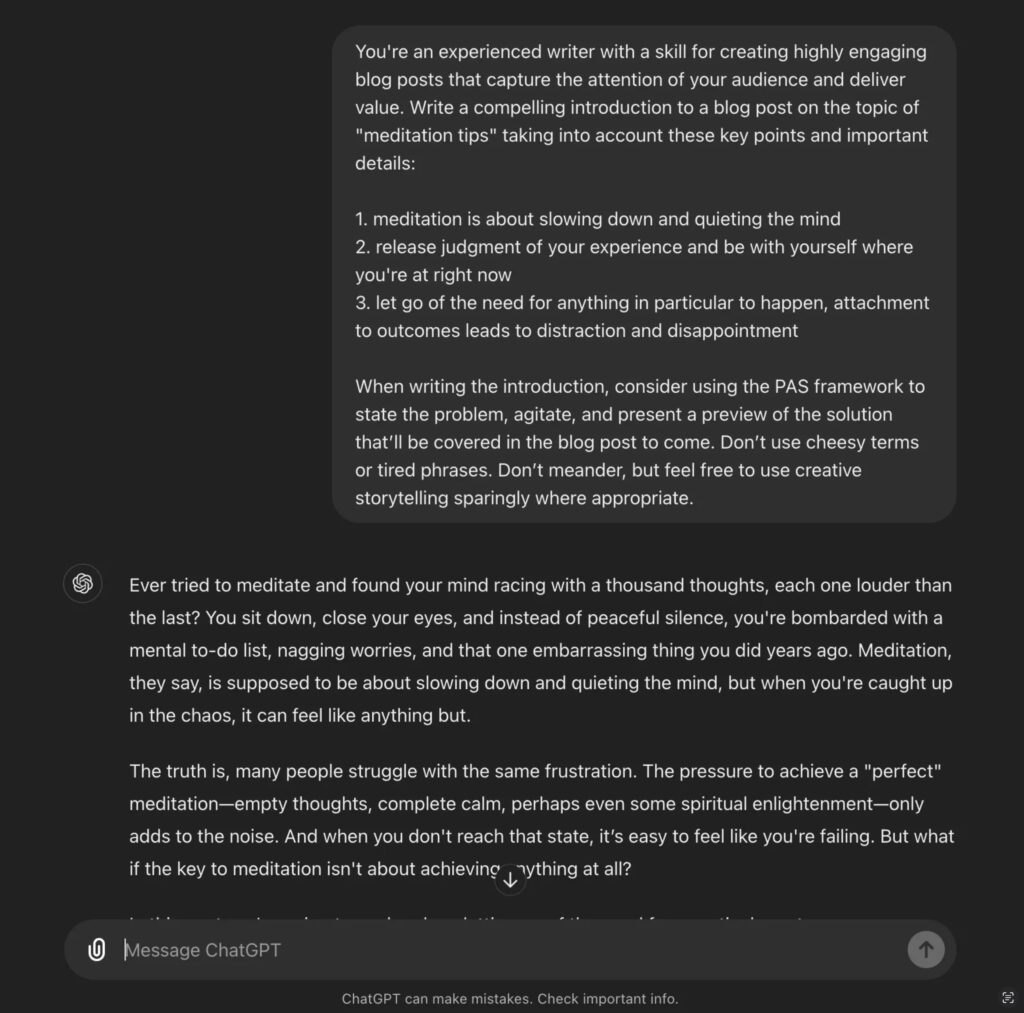
Write first draft introductions in just a few clicks using my free blog introduction writer .
2. Conclusions
All great blog conclusions share one thing in common: they effectively call your reader to action. Someone who makes it to the end of your article, is highly engaged with what you’re sharing. This ChatGPT prompt for writing action-oriented conclusions, will steer you in the right direction, to building deeper relationships with your readers.
And here’s a preview of what you can expect ChatGPT to do, using this conclusion prompt:
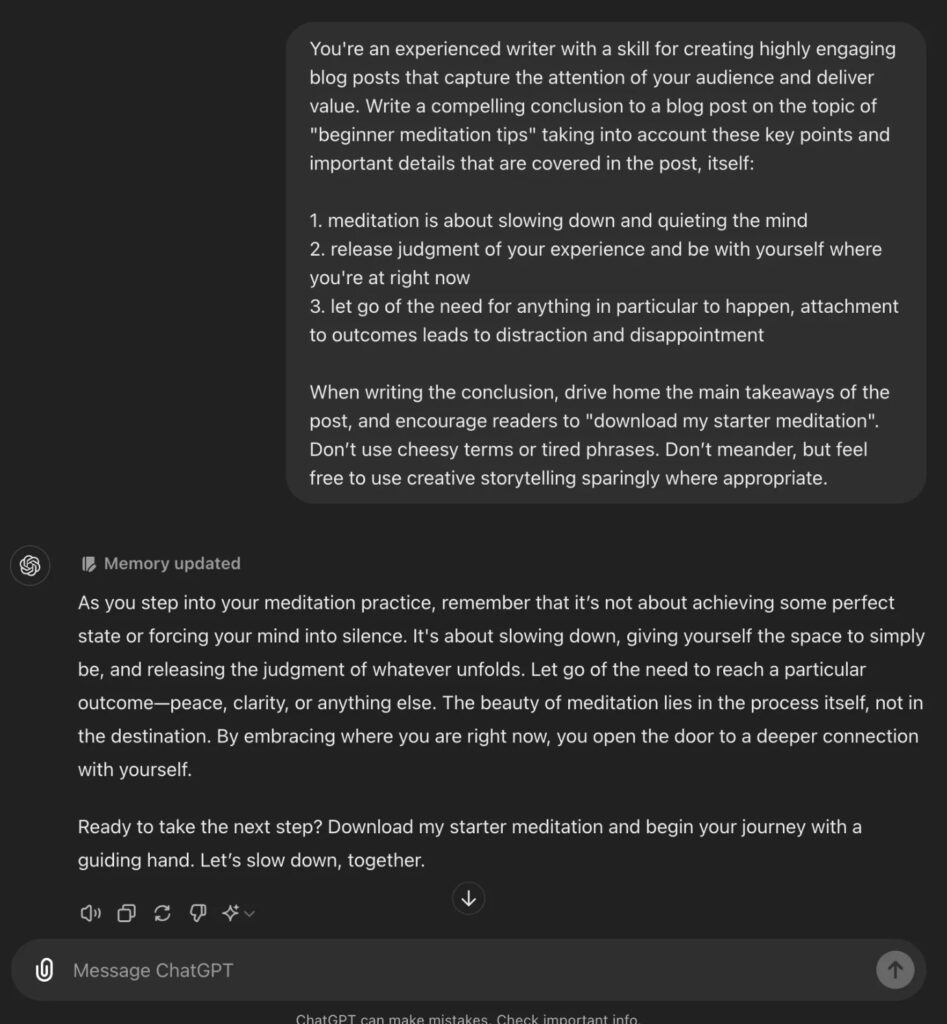
Craft compelling conclusions in just a few clicks with my free blog conclusion generator .
3. Outlines
Let’s say you have the right blog post idea already loaded up and ready to go… but you’re not so sure about all the details the article should cover. I recommend outlining as much of an article from your own base of knowledge & experience when you can—but in those times when you could use a little inspiration, this ChatGPT prompt for writing an outline, will give you some fantastic starting points to consider.
Here’s a preview of what you can expect with this ChatGPT prompt for writing article outlines:
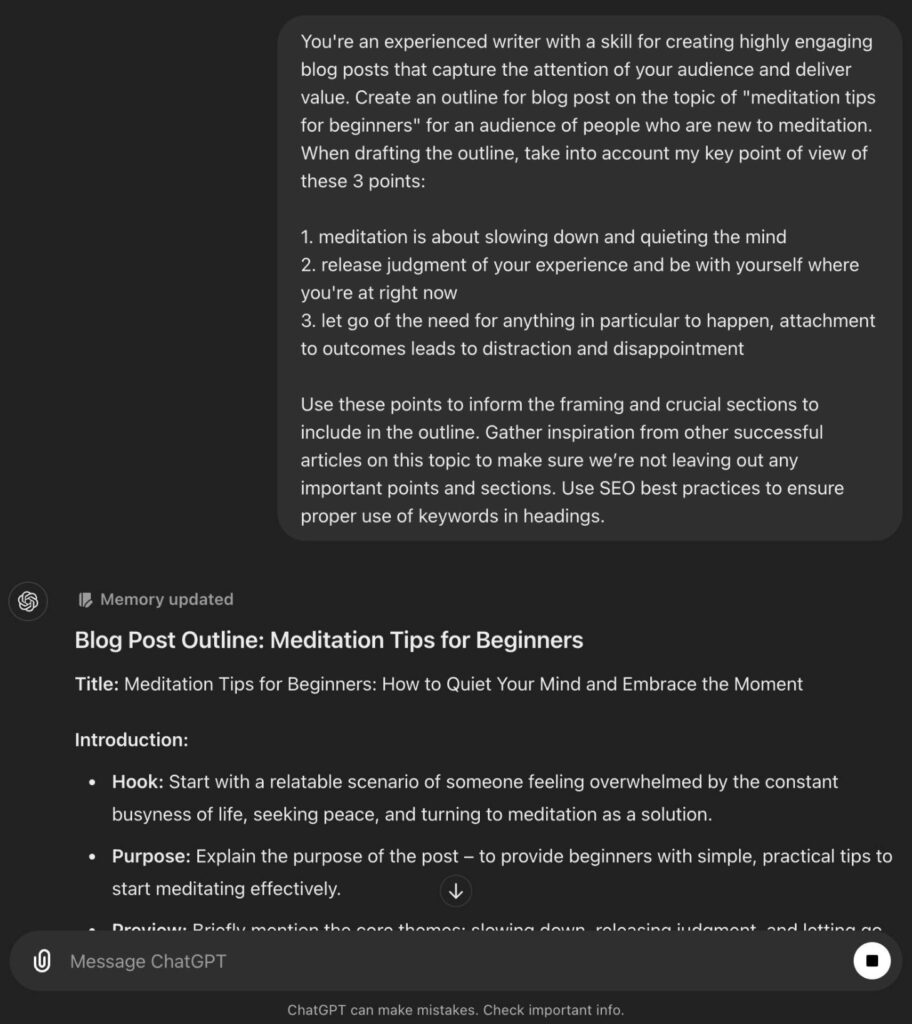
Create full outlines for your articles using my free blog outline generator tool.
4. Sections of Articles
Another great use case for AI tools like ChatGPT, is in creating smaller chunks of content (think paragraphs and header sections), that take your stance on a particular topic, then expand a bit—giving you more to work with and weave into your articles.
Using this ChatGPT prompt to write sections of your content, here’s an example of what you can expect:
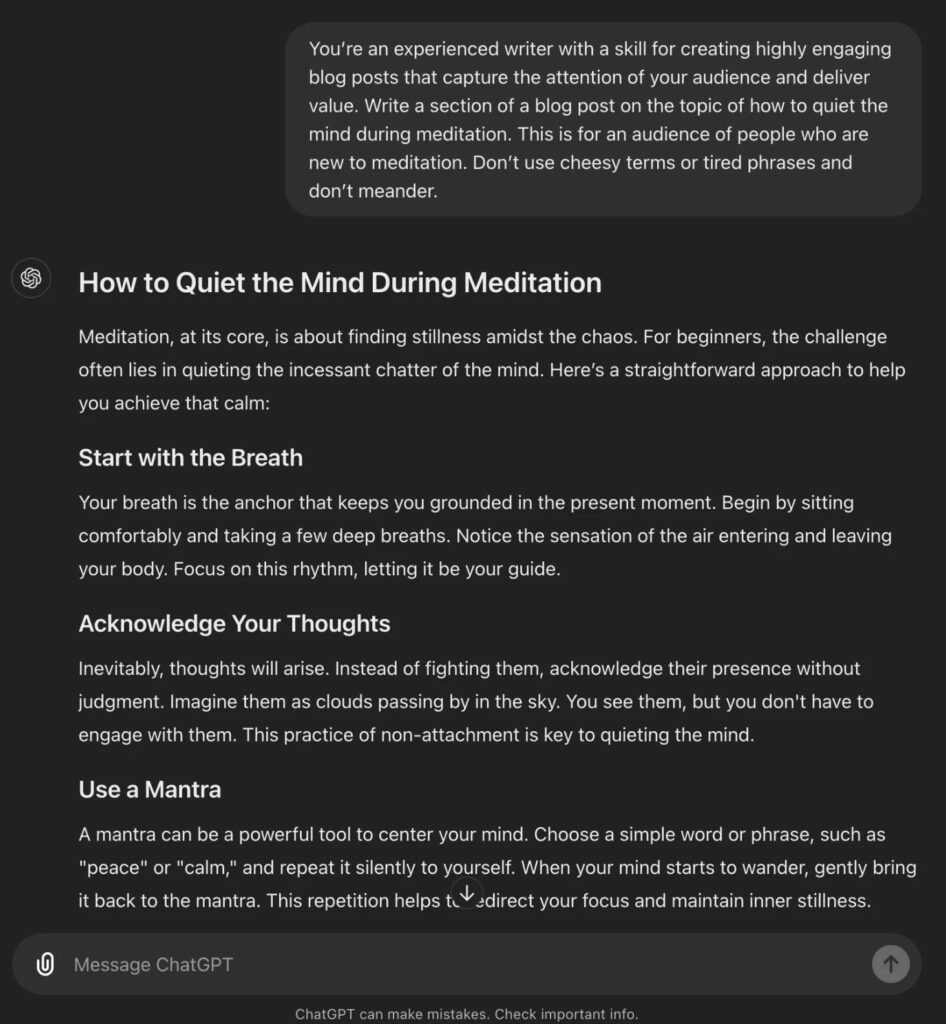
Take my free Paragraph Generator tool for a spin, to speed up this process.
5. Full SEO-Optimized Articles (First Drafts)
Ah yes, writing full SEO-optimized articles using ChatGPT. I knew why you were really here.
I have an entire guide to my personal AI blogging process that goes deeper on my thoughts around how to best utilize tools like ChatGPT and RightBlogger to write blog posts with the help of AI—but the key takeaways are two things:
- Treat AI-generated blog posts as first drafts : We’ve all seen the imperfection of AI on full display more times than we can count, and nothing is more true than if you give AI very little direction to work with, it’s going to be wildly unpredictable in its output . The more guidance you give it (in the form of a detailed prompt), the better your first draft will be, but it’ll always be a first draft, because…
- Weave as much of yourself & your take into the creation process as possible : AI doesn’t have a lived body of human experience, it can’t draw on the real examples inside your head, and it won’t be able to tap into your human emotion. It’s an imitation of all these things, and in that sense it’ll always be non-human. Full articles from sources like ChatGPT and RightBlogger can be pretty impressive, but they still need your editing, your style, real-life examples, stories, and personal experiences.
The first step to writing an SEO-optimized first draft article that uses real-time Google search data, is crafting a great outline.
Step 1: Generating a detailed, SEO-forward outline for ChatGPT to use as a foundation.
Here’s step one of writing a full article draft using ChatGPT, focusing in on creating a great outline first :
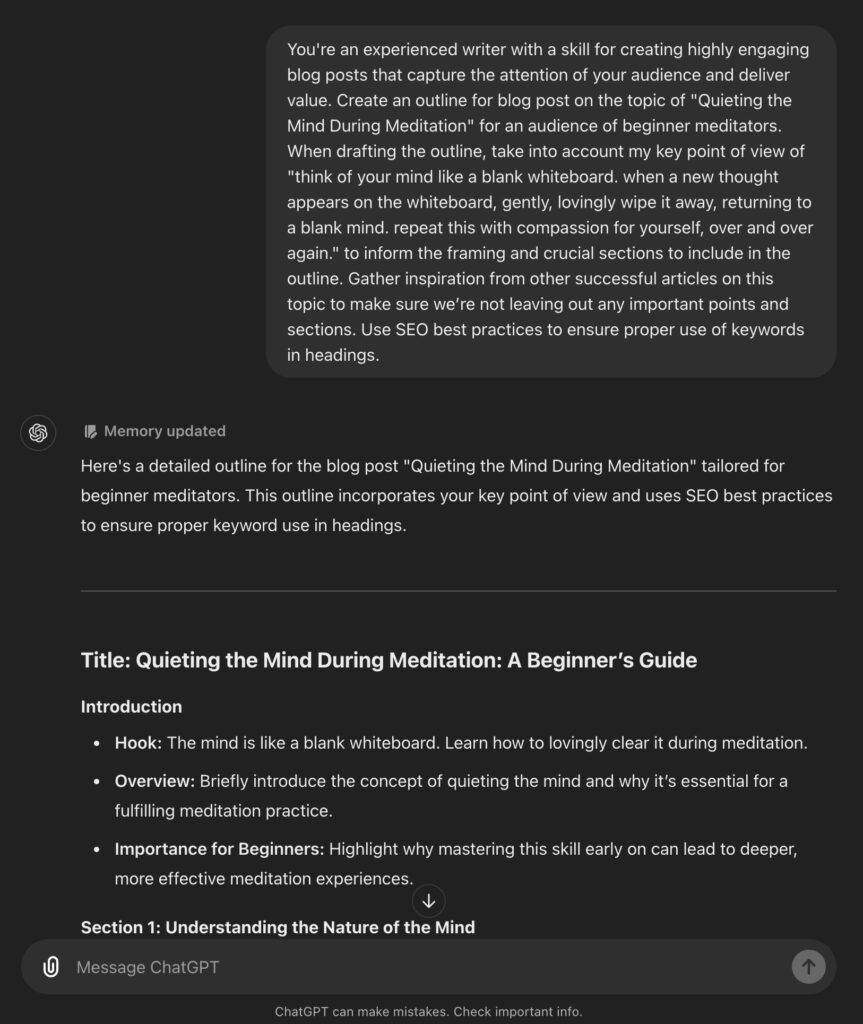
Step 2: Make edits to refine your outline.
Interact with ChatGPT to make any necessary edits and revisions to the outline you’ve created.
Please don’t skip this step, it’s crucial to making sure you’re injecting your take, beliefs, style, personality, and experience into the AI writing process. Without you , I can promise your ChatGPT outputs will sound more like AI and be a total pain to level up during your editing process.
Step 3: Write the full first draft of your article using the dialed in outline you’ve created.
And here we go—a preview of what ChatGPT’s doing with this prompt. Not bad, but could use a whole lot of love in the formatting department:
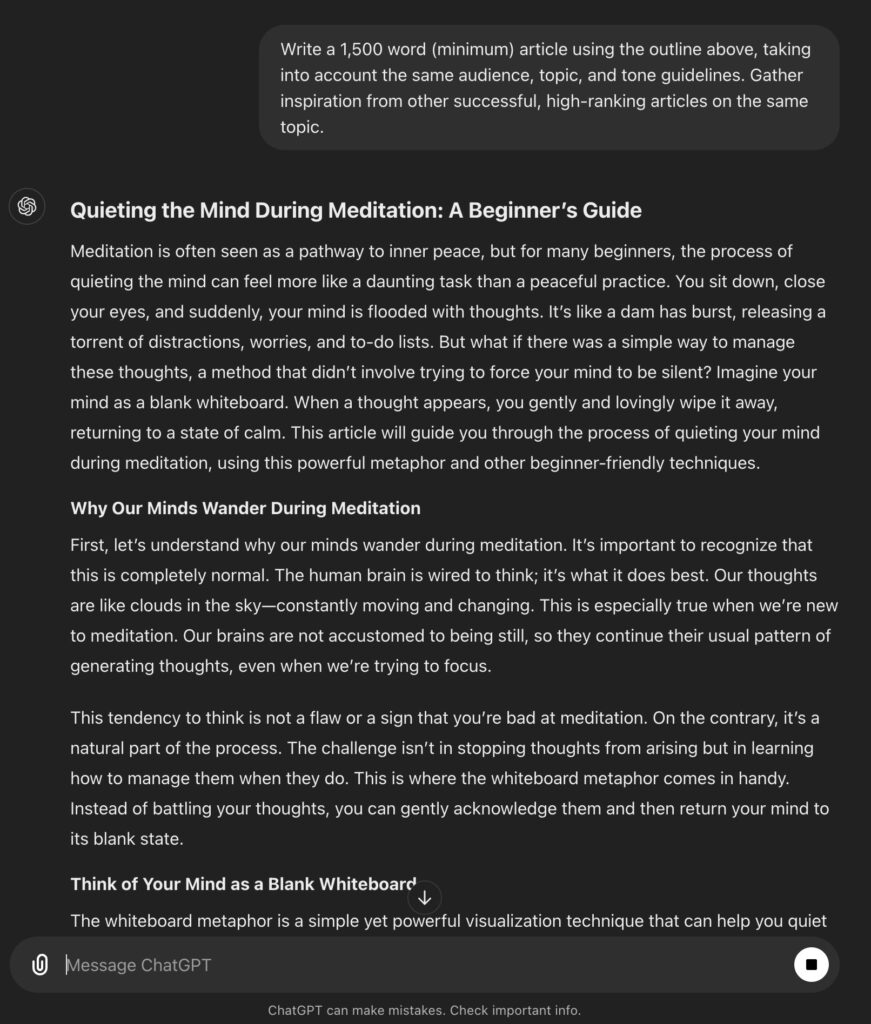
This is kind of a lot, I know. Simplify your AI writing experience by using my free AI article writer . For a super-powered version of this tool, you’ll wanna use RightBlogger’s Article Writer , where we’ve really dialed things up about a hundred notches.
If you dig these ChatGPT writing prompts, you’ll find even more in my roundup of all my top ChatGPT prompts for bloggers , too.
6. FAQs (Frequently Asked Questions)
Researching the most frequently asked questions on a topic you’re considering writing about, is one of the best ways to create genuinely helpful content that real people are already searching for answers about. Use this ChatGPT writing prompt to get the best FAQs (and their answers) in seconds:
Here’s what you can expect from this ChatGPT prompt for writing relevant FAQ content:
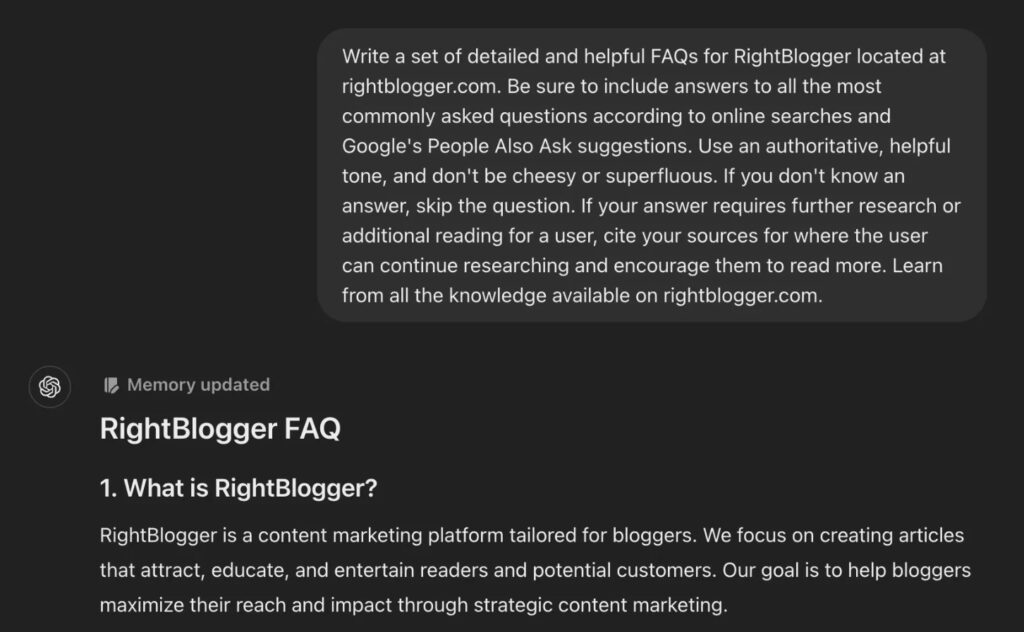
We built an FAQ Generator Tool inside RightBlogger that’ll quickly source the most relevant key questions related to your topic, and provide helpful answers, too. Just be sure to double check everything is lookin correct—we know AI sometimes has a mind of its own.
Ideation and Planning ChatGPT Writing Prompts
For me, when great ideas are flowing, they usually come in huge waves and I do my best to capture all of them—even if it’s in the form of a quick audio note or jotting them down in my creative journal if I’m away from my studio.
Yet other times, I can feel totally uninspired. It’s a crazy hot & cold thing sometimes, being a creator.

In times of need, I’m a big fan of turning to tools like ChatGPT to stock me back up with potential ideas and plans for shaking myself out of a creative funk. Here are my favorite prompts for just such occasions.
7. Article Ideas
When your content calendar is running low, and you’re not feeling particularly creative, try using ChatGPT as a tool to spark your fire again. Here’s my ChatGPT prompt for getting a crop of new article ideas within my niche :
Here’s what a slightly tweaked version of ChatGPT ideation prompt looks like in action (you’ll get very similar results):
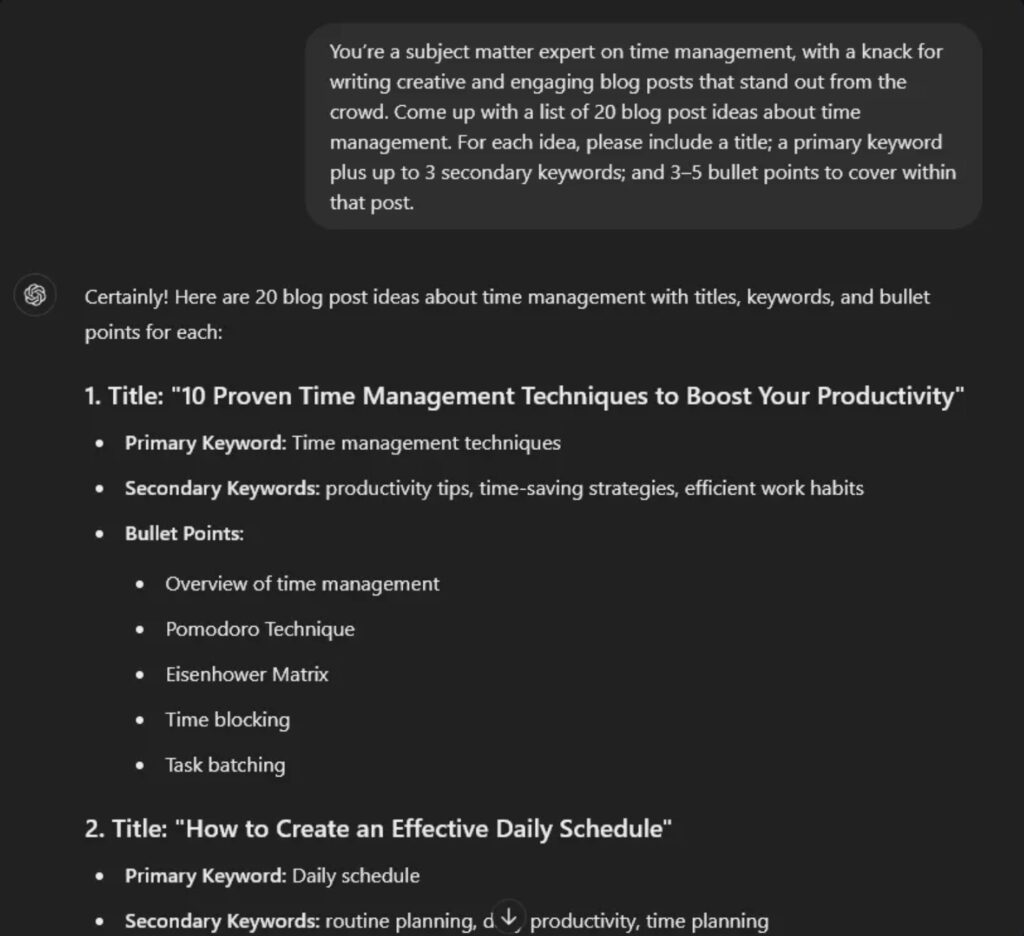
Try my free blog post idea generator to get a jumpstart on your brainstorming process in just a few clicks.
8. Content Plan + Publishing Schedule
Knowing what you’re going to publish, and when, is a great practice to keep once you’re running a content-fueled business that shows a clear ROI for your time spent creating great content. Here’s my ChatGPT prompt for creating a content plan (aka publishing schedule):
Here’s one example of what this ChatGPT content planning prompt looks like in practice:
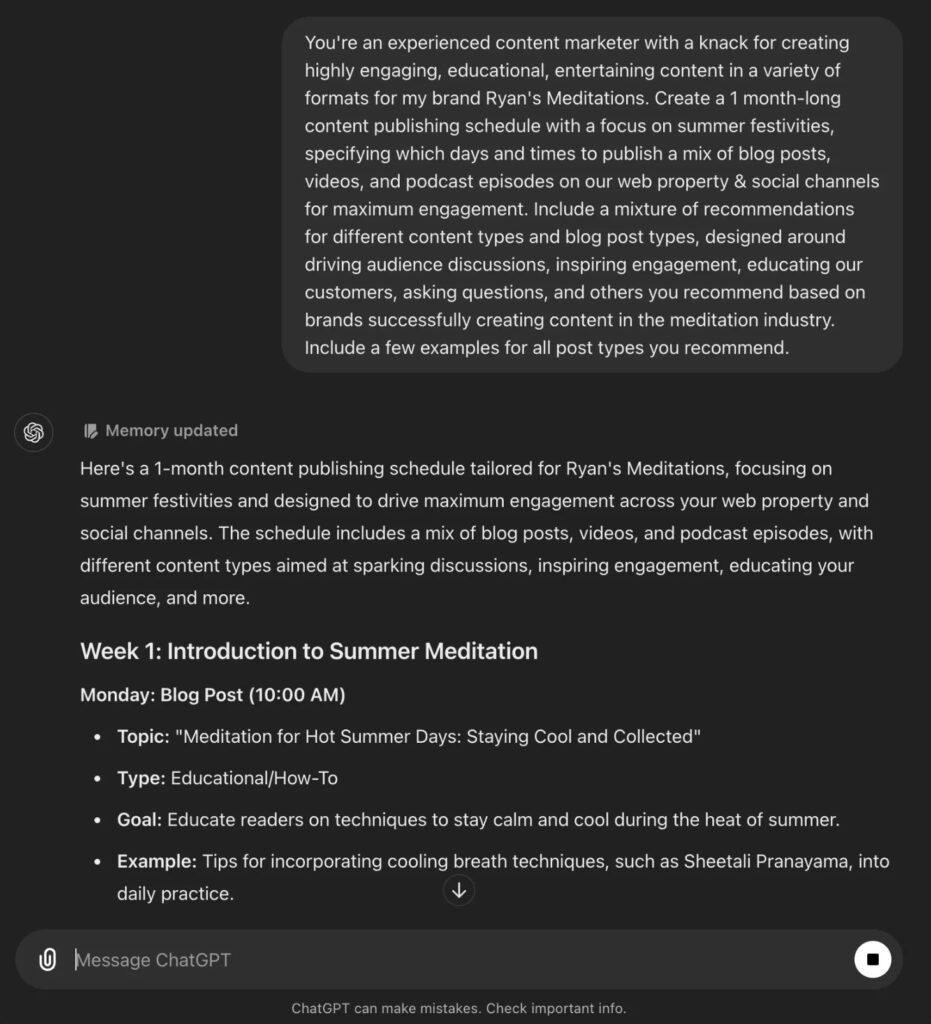
Now, let’s dive into using ChatGPT for research and identifying opportunities where you could create content that’ll attract an audience.
Research and Opportunity Identification ChatGPT Writing Prompts
If you think you can do more research than AI models that are trained on virtually the entire Internet, then I’d like to be your friend. For the rest of us, we now have ChatGPT to help with more targeted research.
Perhaps one of the top areas where AI writing tools like ChatGPT and RightBlogger really stand out, is in conducting research to figure out the absolute best, audience-informed topics for you to create content about.

Not knowing how to properly research is a common challenge in your early writing days. The right ChatGPT prompts can help activate this powerful assistant and help you maximize your researching time investment.
9. Keyword Research
There’s an entire art and science to doing keyword research , but in the world of AI, you can get some really fantastic, actionable insights from the right ChatGPT prompt. Here’s mine:
Here’s what this ChatGPT prompt for keyword research looks like, in action:
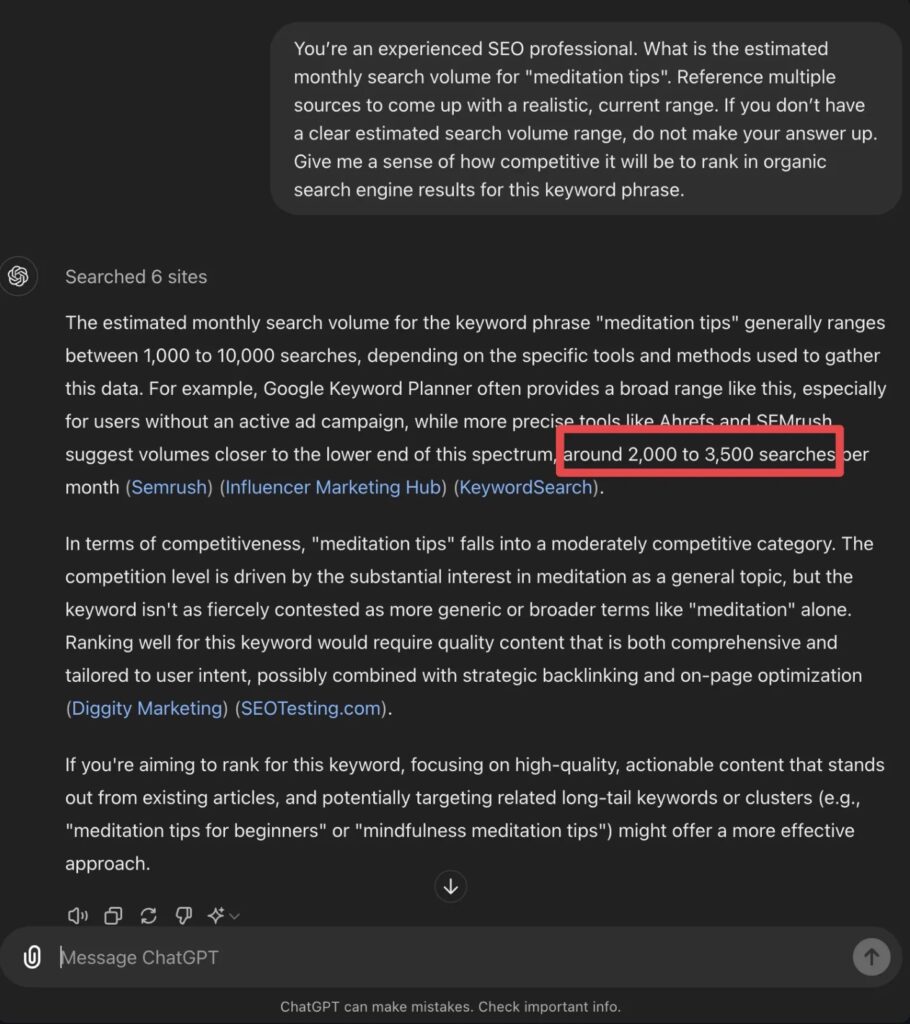
My free keyword research tool has quickly become one of the most popular in my stable of free blogging tools. Take it for a spin to simplify your keyword research process today.
10. Keyword Clusters
Keyword clusters are a group of related keywords that all have some topical overlap and often, similar search intent. Creating a keyword cluster is a brilliant way to approach mapping out a content strategy that has the potential to rank your writing for tons of terms in your niche. Here’s my ChatGPT prompt for keyword clustering:
Here’s what this keyword clustering prompt looks like inside ChatGPT:
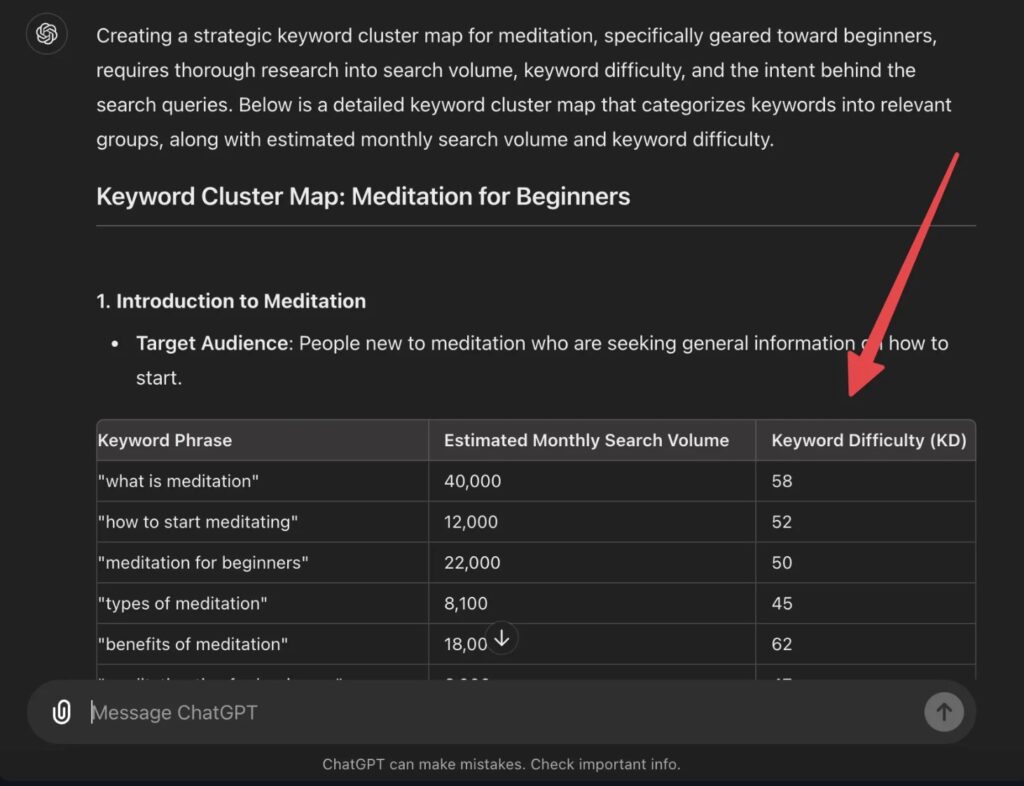
Dig this one? I made a free keyword cluster tool , because I love cluster mapping so much. I think you’ll love it, too.
11. Long-Tail Keywords (People Also Ask)
Now for one of my favorite content research secret weapons—the People Also Ask section of Google search results:
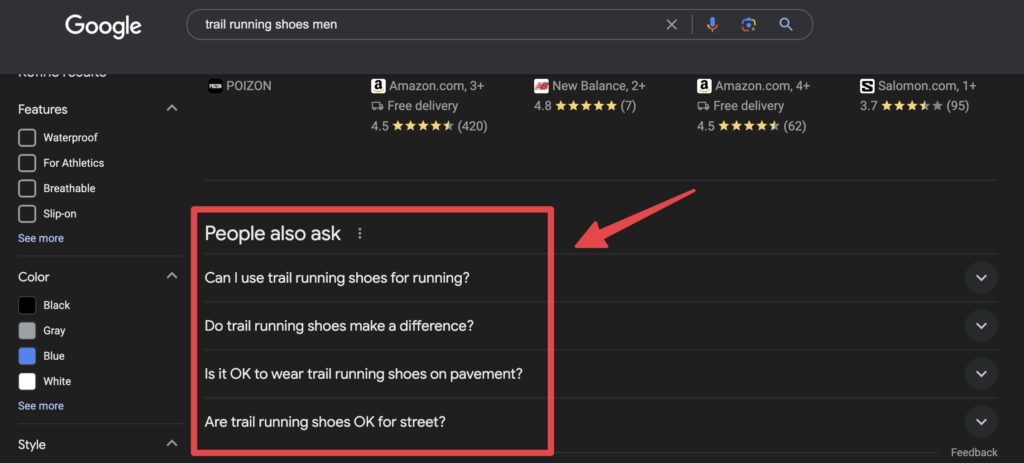
Literally all 4 of these topics would make FANTASTIC articles & videos for a creator in the running or hiking space that wants to earn from affiliate programs . Sheesh, I wish I had more free time…
Anyway, AI tools like ChatGPT and RightBlogger have access to real-time Google search data, so they can quickly perform a search and list out all the most relevant long-tail keyword topics that real people are searching for online—giving you some of the richest, least competitive content ideas to get working on.
Here’s what you can expect with this People Also Ask ChatGPT prompt:
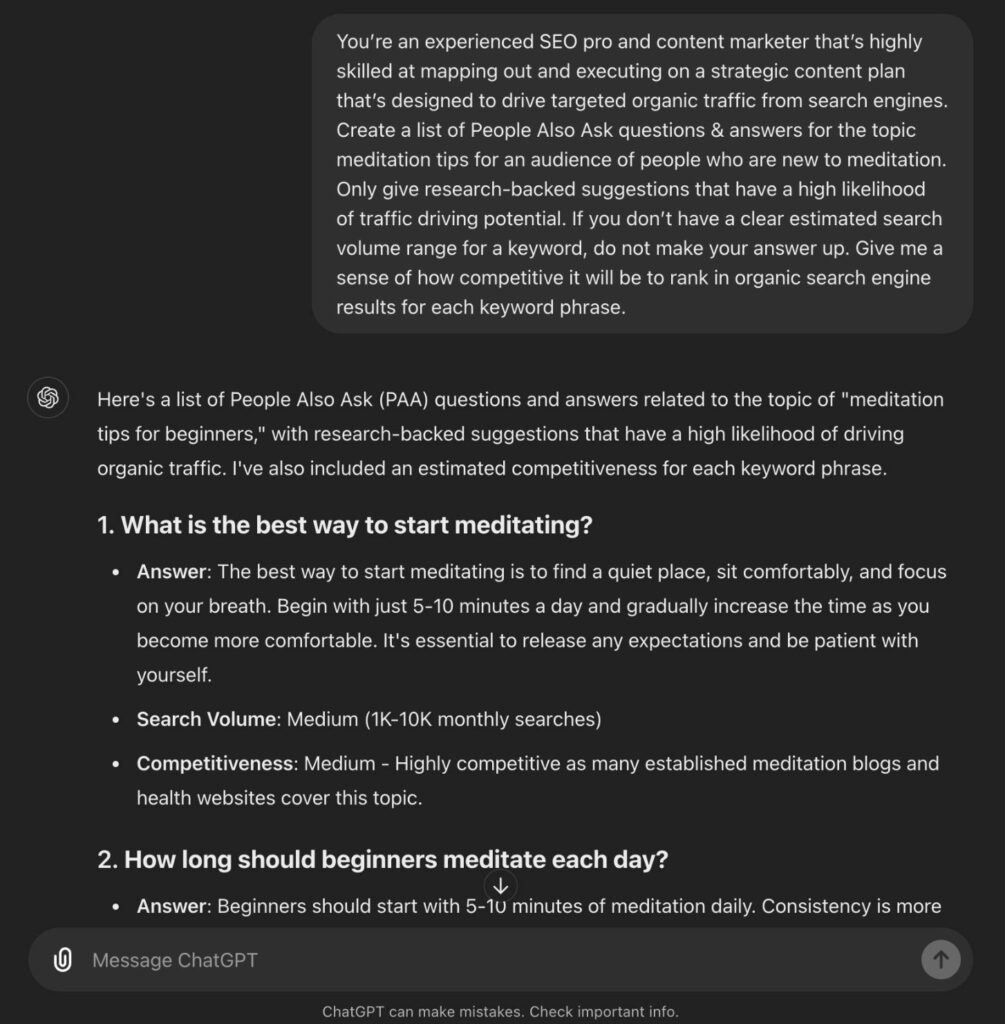
Try RightBlogger’s People Also Ask Tool to instantly source long-tail keyword opportunities and get fantastic starter copy to answer those questions in content for your site.
SEO-Optimizing, Improving, Repurposing, and Promoting Your Content
Once you’ve created your content, there’s still a whole lot more that goes into growing a successful business around your writing .

These are my favorite ChatGPT prompts for everything from SEO-optimization, to promoting my writing, and repurposing it for different formats & platforms.
12. SEO-Optimize Your Writing
SEO (search engine optimization) is the process of thoughtfully finding the balance of writing for humans & search algorithms at the same time. It’s a far more in-depth process than we can cover here, but it essentially helps you tune up an article you’ve written—in a way that gives it the best possible shot at ranking high in Google search results .
This is the ChatGPT prompt I use for optimizing an article that’s already published. Alternatively, if you have the copy from your working draft, you can paste that into ChatGPT and get the same analysis.
Here’s that AI prompt, in action over inside ChatGPT:
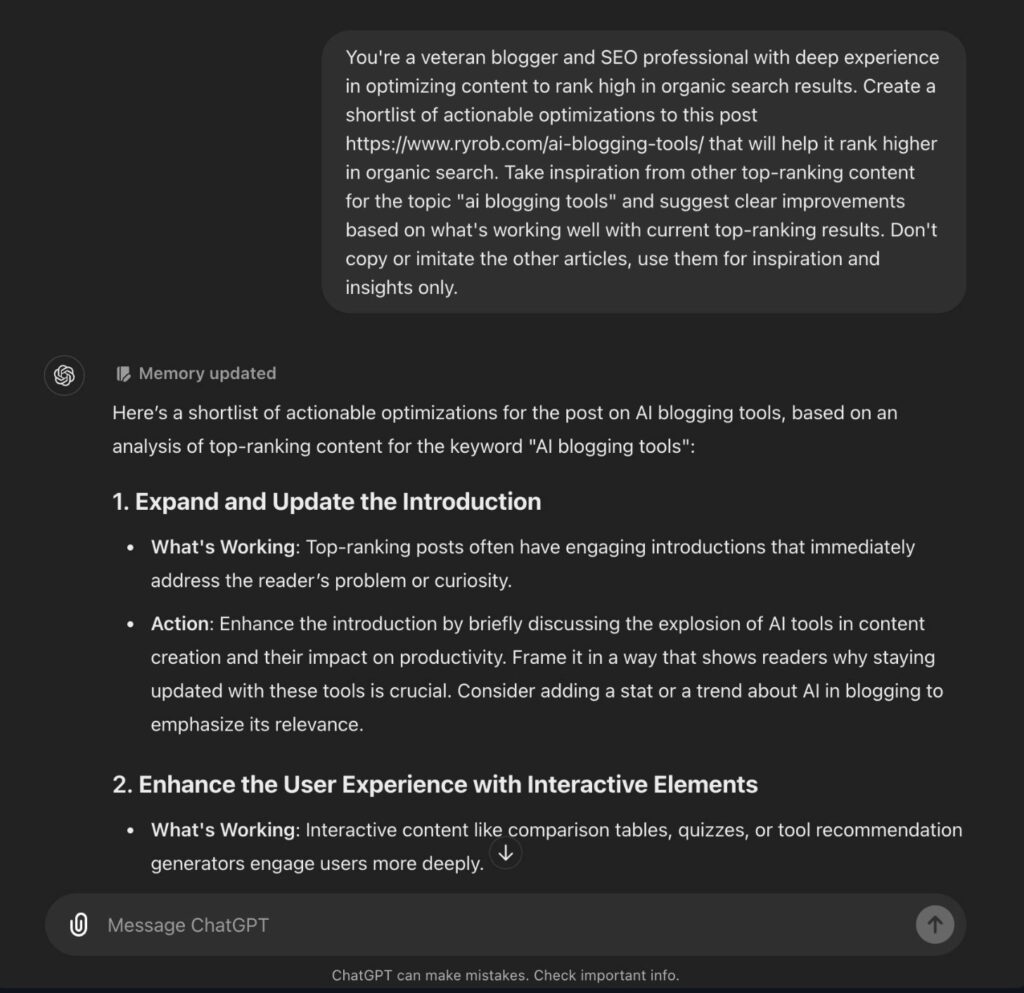
You’ll still need to take action on the SEO-optimization suggestions, but you can sleep real good at night knowing these insights come from a deep well of ‘knowledge’ about what Google will rank high in their search results.
13. LinkedIn Posts
I try and post to my LinkedIn at least a few times each week, but sometimes I go literally months without sharing updates or weighing in with my take on something that’s going down in the content creation space. This ChatGPT prompt for writing LinkedIn posts is super helpful in those moments when I’m not feeling inspired.
Here’s an example of what you can expect with this ChatGPT prompt for writing LinkedIn posts:
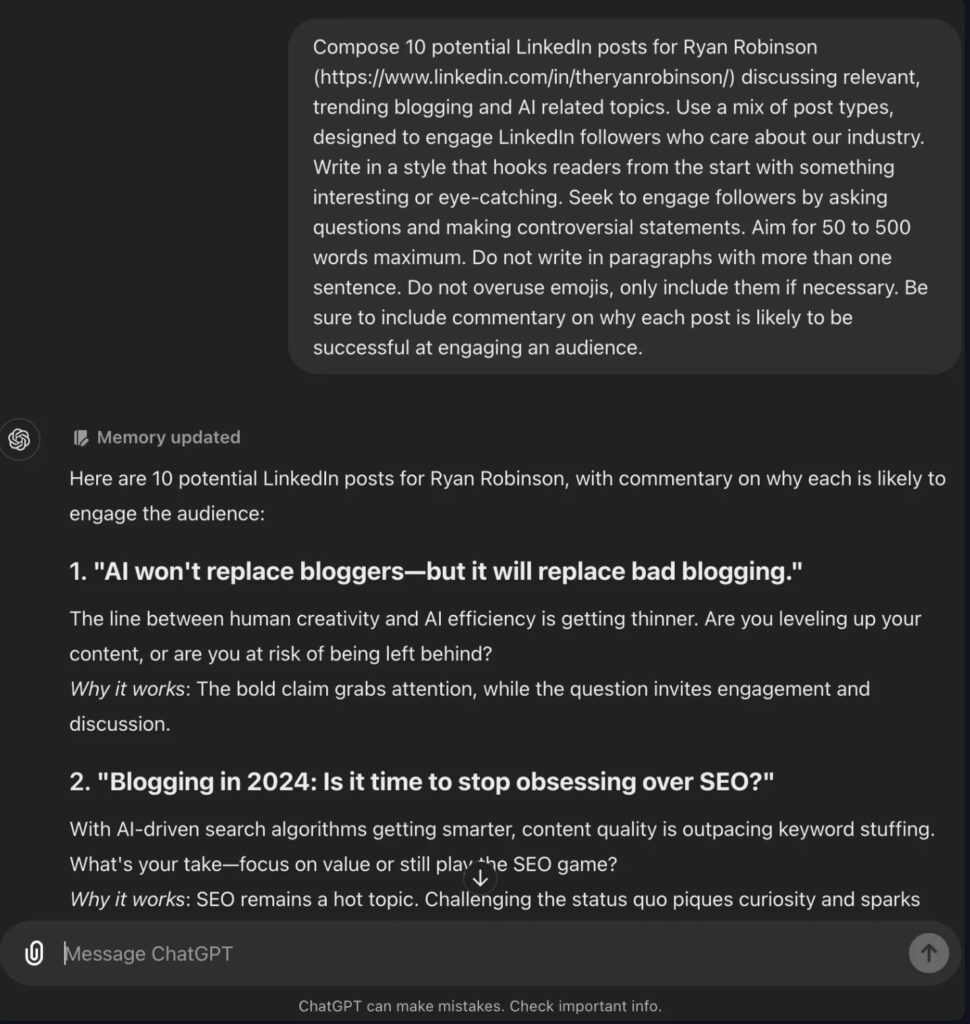
Take RightBlogger’s LinkedIn Post Generator for a spin with a free account, today.
14. Tweets (X) Posts
Same story, different platform for me. I used to spend a lot of time on Twitter, but these days, I don’t get as much personal joy out of social media—so when I need some ideas for what to share with my community, here’s the AI prompt I keep handy:
Here’s this ChatGPT prompt for writing tweets, in action:
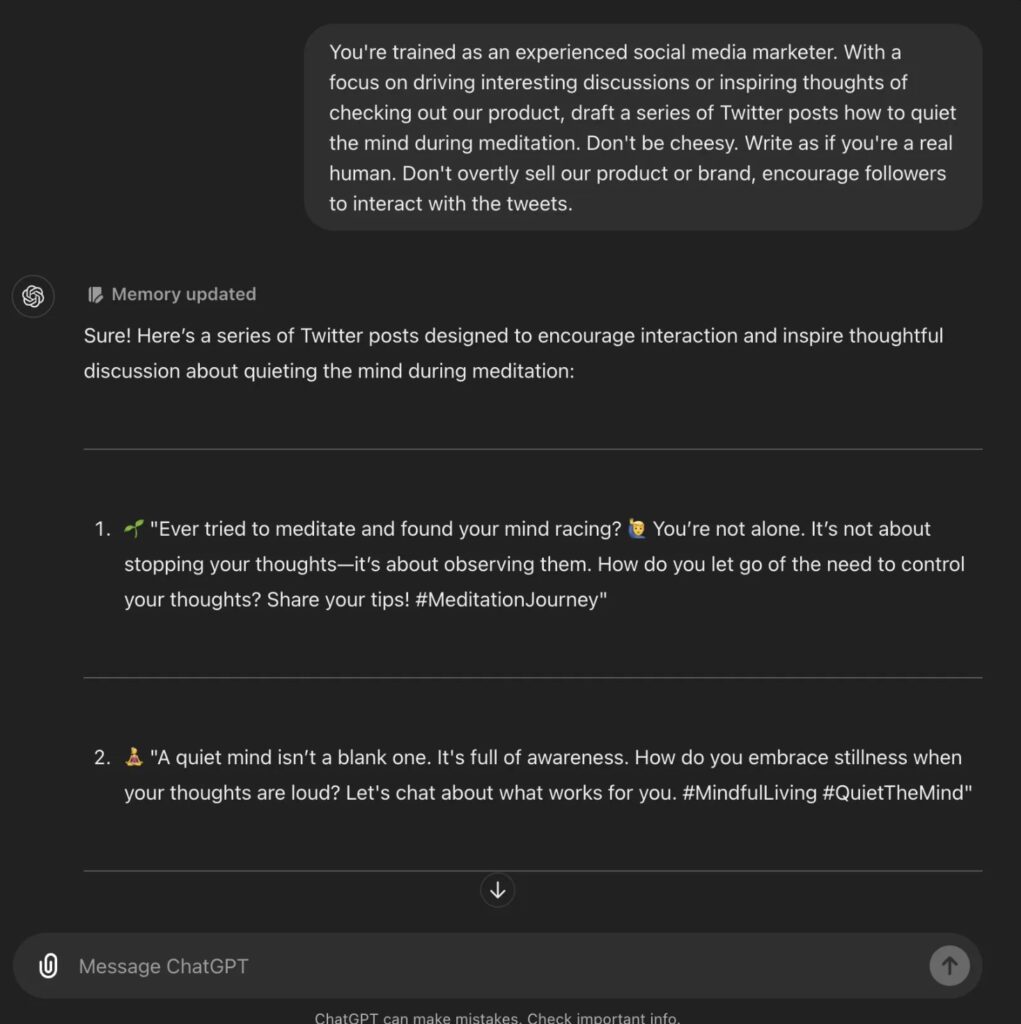
Take RightBlogger’s Tweet (X Post) Idea Generator for a spin with a free account, today.
15. Grammar and Spellcheck
There’s nothing wurse than hitting publish and having a few unnoticed typos or grammar mistakes sprinkled throughout your writing. Use this ChatGPT prompt for checking your grammar and spelling, in a snap:
This one’s pretty self-explanatory, so no example image necessary—get your content edited & cleaned up by a powerful AI assistant.
Take my free grammar fixer tool for a ride today, and make your blog editing process even quicker.
16. Content Gap Analysis
Ever wonder why some articles outrank yours in Google search results and drive more traffic as a result? Well, it turns out AI tools like ChatGPT and RightBlogger (our Content Gap Analysis tool is sick), are absolutely fantastic at conducting this kind of analysis & reporting back with actionable takeaways to improve your writing in the eyes of search engines. Here’s my content gap analysis prompt:
Here’s a preview of what this content gap analysis prompt will generate for you:
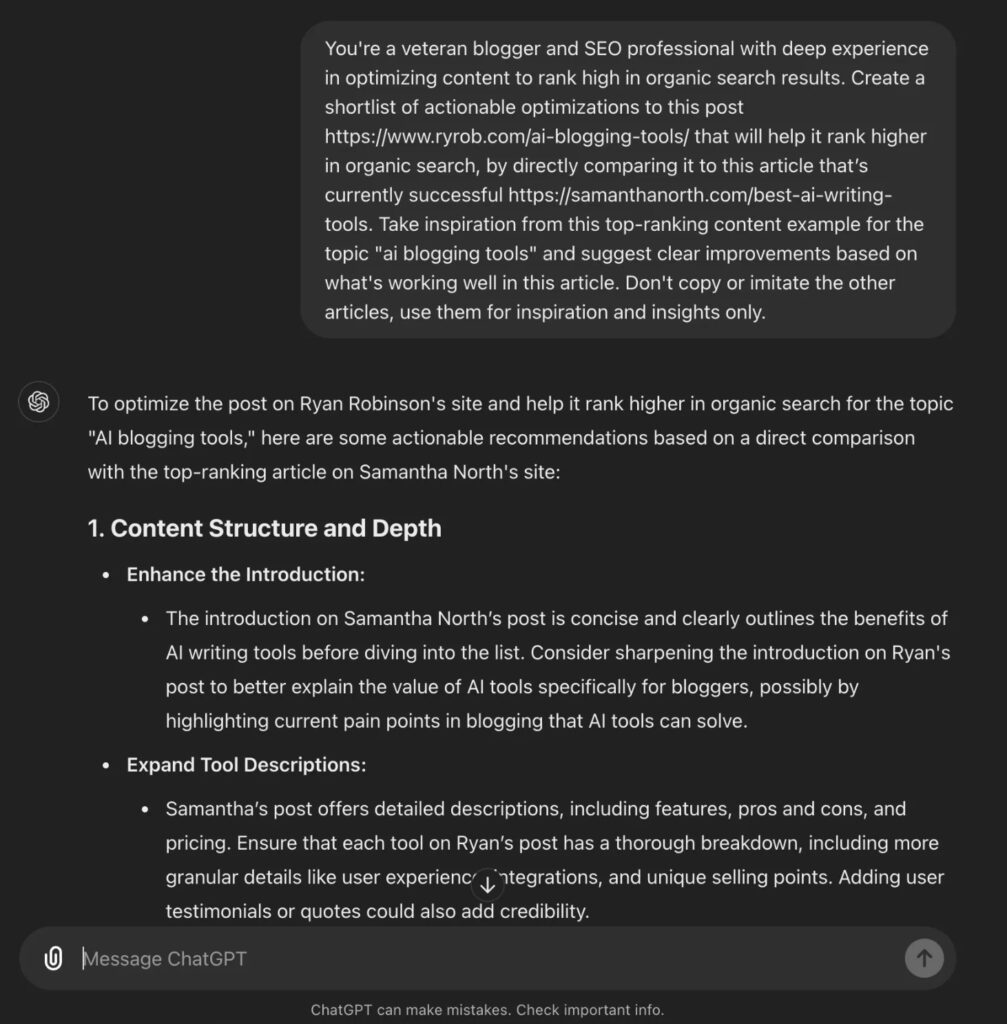
We have an even more powerful Content Gap Analysis tool inside RightBlogger that utilizes multiple different data sources and complex prompting. I know you’ll dig it if you give it a try.
My AI Writing Prompt Formula (to Get Better AI Outputs)
If snagging some good prompts is like being handed a fish, then learning the skill of prompt engineering and how to use ChatGPT like a pro, is like teaching yourself to fish. Oh, and you can even use DALL-E inside ChatGPT to generate unique stock images. Not bad…

Learning to prompt is a skill, and a great investment in your future as a writer, to learn how to weave in powerful AI tools to your process where it makes sense for you .
Here’s my ChatGPT prompt formula that’ll significantly level up the outputs of any prompt you give it:
- Task : This one is straightforward. Tell the AI what you need. It could be writing an intro, drafting a blog post, or generating ideas.
- Context : Give as much background and detail as possible at this stage. The more specific you are, the better. Let the AI know details that are important to the task (like what your take is on a subject you’re writing about).
- Exemplar : Just a fancy way of saying “example.” Explain to ChatGPT exactly what kind of output you’re looking for. Including real examples will help it get closer to what you envision.
- Persona : Who should the AI “be” while writing this content for you? Imagine that AI can wear different hats for different tasks. Explain who it is within your prompts, and it’ll have a much better understanding of how to go about creating your output.
- Format : Share which format you want the final product to come in. What exactly should the AI output look like? Do you want a list, a paragraph, a blog post with multiple sections, maybe just some bullet points? Be specific here.
- Voice : Always define the style and tone when you’re writing a ChatGPT prompt. Do you want your output to be casual, formal, playful, something much more nuanced? Let these tools know, so your writing outputs will match your vibe.
If you can nail these elements at a high level within your ChatGPT prompts, then I can promise this AI prompt formula will serve you well.
Drop any questions or share your experiences with AI in the comments. Let’s help each other grow and write amazing content!
Hi I'm Ryan Robinson
I'm a blogger, but I'm not my blog. I am not my business either. Occasional podcaster and very-much-recovering side project addict. Co-Founder at RightBlogger . Join me here, on ryrob.com to learn how to start a blog and build a purpose-connected business. Be sure to take my free blogging tools for a spin... especially my wildly popular free keyword research tool & AI article writer . They rule. Somehow, I also find time to write for publications like Fast Company , Forbes , Entrepreneur , The Next Web , Business Insider , and more. Let’s chat on Twitter (X?) and YouTube about our feelings (and business, of course).
Leave a Reply: Cancel reply
Save my name, email, and website in this browser for the next time I comment.
4 replies to “16+ Best ChatGPT Prompts for Writing (My AI Prompt Formula)”
Thanks for the helpful blog Ryan.
Thanks for the 16+Best ChatGPT Prompts for Writing . More Grace to you. l am a newbie, attempting to write blog on Christian topics, and other topics as l May consider relevant. kindly, guide and advice me on how to get started.
Thanks for your helpful Prompts for Writing.
Great! Information.
What are your chances of acceptance?
Calculate for all schools, your chance of acceptance.
Your chancing factors
Extracurriculars.
How to Write the Smith College Supplemental Essay 2024-2025

Smith College is a private liberal arts women’s college in Western Massachusetts. The school boasts small class sizes and close advising for over 50 areas of study. Smith is also part of both the Five College Consortium , which allows students to take courses and participate in extracurriculars at Amherst College, Mount Holyoke College, Hampshire College, and UMass Amherst.
Smith is pretty selective, so writing a strong essay can definitely help increase your chances of acceptance. Here’s how to respond to their supplemental essay prompt.
Smith College Supplemental Essay Prompt
What personal experiences, background or abilities would you bring to this residential environment to share with your neighbors and what would you hope your neighbors would share with you (250 words).
Smith wants to know about your individuality and worldview through your experiences, backgrounds, and abilities, and this aligns most with the Diversity archetype . Showcase how your unique perspective benefits the community and how you engage with others. As there is an emphasis on “neighbors,” make sure to prioritize community as a theme, whether that’s about embracing differences, serving the people around you, or any other variation of being a contributing member of your community.
Essentially, you are being asked to reflect on the aspects of your identity, skills, and personality that will shape how you engage with Smith College’s residential campus community. Admissions officers want to know how you can enrich the experiences of your future neighbors, as well as what you hope to gain from living in a diverse and tight-knit environment. It’s an opportunity to highlight your ability to contribute to a communal space, while also demonstrating humility and openness to learning from others.
To brainstorm some ideas for what you’ll write about, think about the following questions:
- What personal experiences or aspects of your identity (culture, family background, hobbies, talents) would shape your role in a residential community?
- How have you contributed to your community in the past? How would that translate to a college campus or dorm environment?
- What specific values or qualities do you want your living space to reflect?
- What are you curious about learning from others who may have different backgrounds or interests than your own?
- How do you envision creating meaningful relationships with your neighbors?
Like any supplemental essay, a good response will be specific and personal. Make sure to share details about your life that impact how you interact with others; this could include any aspect of your identity, including ethnicity, race, culture, religion, socioeconomic class, gender and sexual orientation, hometown, illness or disability, and even interests and hobbies.
How can your experiences or abilities related to one of these dimensions enrich the lives of the people around you? Think about how you contribute to your community or how you will. Then, dive into what you hope to gain from your peers to express your openness to learning from others—engagement is mutual, so don’t neglect this part of the prompt.
Check out these examples below:
Good Example : “ I’ve always felt that food is a way to bring people together. Growing up in a Filipino household, Sunday afternoons were spent cooking lumpia and adobo with my cousins. I want to recreate this sense of warmth and familiarity in my life at Smith by hosting cooking nights where we can share our favorite family dishes. I can already imagine the smell of sizzling garlic and soy sauce filling the kitchen as we cook and talk about the comfort foods that remind us of home. But more than that, I hope my neighbors will share their own stories and traditions with me—whether it’s teaching me a new dance move, introducing me to their favorite songs, or showing me a special recipe that I can add to my collection .”
This example gives a vivid picture of how the student will contribute to the residential community by sharing memories and traditions related to their cultural background. It also balances their desire to learn from others, creating a sense of true exchange. The focus on food as a way to connect adds a personal and tangible element with elements of storytelling.
Bad Example: “ In the Smith dorms, I would bring a positive attitude and help others when needed. I’ve always been someone who people can count on, and I hope that my neighbors will see that I am trustworthy to talk to when they need help. I also hope that I will meet people from different backgrounds who can teach me about their experiences when they come to me to talk something out. It will be great to live with people who are different from me and learn from them. Creating authentic connections with my neighbors is an important way to create a community and make sure everyone feels supported. ”
This example is generic and doesn’t show any specific aspects of the student’s background or personality. While it mentions wanting to help others and learn from peers, it lacks detail on how the student plans to engage with the community. It could be written by anyone and doesn’t provide any personal reflection or depth to the writing.
Your response should be intentional and reflective when it demonstrates how your personal background and abilities will enrich your residential community at Smith. This will help show admissions officers that you’re ready to be an active, engaged, and open-minded member of the campus community who contributes to the culture of the college.
Where to Get Your Smith College Essays Edited for Free
Do you want feedback on your Smith College essays? After rereading your essays countless times, it can be difficult to evaluate your writing objectively. That’s why we created our free Peer Essay Review tool , where you can get a free review of your essay from another student. You can also improve your own writing skills by reviewing other students’ essays.
Need feedback faster? Get a free, nearly-instantaneous essay review from Sage, our AI tutor and advisor. Sage will rate your essay, give you suggestions for improvement, and summarize what admissions officers would take away from your writing. Use these tools to improve your chances of acceptance to your dream school!
Related CollegeVine Blog Posts

Expert Tips: How to Write a PIQ
- by Abigail Loomis and Robert Penman
- October 11, 2023

Quick Summary
- Need advice on selecting personal insight questions or writing any college application essay? Get insights from UC Davis Admissions Director, Robert Penman and Admissions blog editor, Abigail Loomis.
With Halloween just around the corner, spooky season is officially here. And there is nothing more spooky than college applications. I felt like I had to write about all of my personal issues, showcasing a hyper-idealized version of myself. I had no idea what the “right” prompts were for me to answer, or how to plan my responses. It was difficult, but it didn’t have to be, says our very own admissions director Robert Penman. He’s teamed up with me to offer you some helpful PIQ tips and tricks.
Understanding Yourself
Socrates said it best: “Know thyself.” The first step in writing your college essays is to understand who you are and how to present yourself. This will guide the rest of your decision-making. There is no need to get existential about this question. I did that and it did not go well. Instead, make a short list of your favorite personal traits, hobbies or interests. Add why you want to go to college or pursue a degree. Think about how your best friend might describe you, or how you would want them to do so.
Choosing Your UC Essay Prompts
For the UC application, you are given eight different prompts and you have to select four. It can be tempting to pick the prompts you think the admissions panels will like best. Instead, go with what shows off your skills, experiences and values. They want to understand who you are. Go back to the list that you made earlier. Consider what aligns with the PIQ prompts. If you are interested in crocheting, for example, then you might look at prompts that discuss creativity or personal talents. Look for the prompts that suit you best . Even if they’re not perfect fits they’ll still get the job done.

Need more PIQ advice?
Click here to learn some Aggie-approved tips and tricks!
Utilizing AI for Your PIQs
This is probably the scariest part, but it doesn’t have to be. Each PIQ is 350 words max, so not much at all. Simply talk about a topic you should be well acquainted with, yourself . You may be tempted to use generative artificial intelligence. You can! AI can be an enormously helpful tool, but you’ve got to do it right.
“Like spell and grammar check, AI can help you write clearly,” says Undergraduate Admissions Executive Director Robert Penman. “You should always get help from family members, counselors and the like when developing your college applications, but remember, you are always expected to submit your own work and not the work of others. AI adds another tool to your arsenal; however, the expectations remain the same. So don’t think of AI as something that will do all of the work for you, think of it as a tool to help you develop your ideas.”
AI can be helpful in brainstorming, refining your ideas, or developing a structure, but the responses generated by AI won’t have the depth or personal insight admissions readers are looking for. The most effective PIQ responses will be in your own voice and share your unique experiences.
Instead of using AI to write your PIQs, use it to create outlines. Outlining is a must, because it gives you a structure. You must be concise. Outlines can help you determine what parts of your response are too wordy, and which need more details. This is the type of work that AI is great for, as it takes pressure off you to nail the format and open up possibilities for true self-expression.
Avoiding Academic Dishonesty
All PIQs are reviewed for plagiarism. Copying and pasting work may cause an application to get flagged. So don’t let your first impression be a bright red “PLAGIARISM DETECTED” written across your application. That will set you apart, but not for the reasons you want.
Admissions committees want you to write in your own voice using clear, simple and direct language. These aren’t essays for your English class. They really want to get to know you and learn about your aspirations and achievements in all of their forms, and AI won’t be able to provide the most important ingredient: you.

Abigail Loomis is a fourth-year political science student and student-editor for the UC Davis Admissions blog. She enjoys spending her time hanging out with the Eggheads on the UCD campus.

Robert Penman is the executive director of Undergraduate Admissions at UC Davis. When he isn’t going over student applications or working to make education accessible to students from all backgrounds, he is spending time exploring Davis and Sacramento with his husband and their two dogs.
Primary Category

IMAGES
COMMENTS
What is a prompt in writing? A prompt in writing is a starting point designed to ignite creativity, guiding writers to explore themes, genres, or emotions. It can be a word, question, image, or scenario, aiding in overcoming writer's block. Keep reading to learn everything you need to know about prompts in writing.
Learn how to create engaging writing prompts and discover expert tips and techniques in our comprehensive guide for your next writing adventure.
This is your ultimate guide to college essay prompts: examples, analysis, and strategies for the full range of college essay questions.
A good writing prompt will help the students understand the type of essay assigned and what topic they are to focus on in their writing. In this lesson, we will discuss how to write effective ...
Read the writing prompt carefully. First, read the prompt once over to get a general sense of the prompt's topic and the position it takes. Then, read it again; this time, focus on the author's thesis and the key point of each paragraph. WRITING TIP: Identify the part of the prompt that tells you exactly what you should write about.
Harvard College Writing Center 2 Tips for Reading an Assignment Prompt When you receive a paper assignment, your first step should be to read the assignment prompt carefully to make sure you understand what you are being asked to do. Sometimes your assignment will be open-ended ("write a paper about anything in the course that interests you").
Even the best writing has to come from somewhere, and when you are struggling to get started, you will feel frustrated. Learning how to create a writing prompt will help you get your creative writing ideas flowing, so you can get past your writer's block and start writing engaging, effective content.
If you're practicing your personal essay skills or just storytelling, these narrative essay prompts are a great way to get started!
To write an essay, one must consider the essay type, essay goal, supporting details, form of the conclusion, and appropriate conclusion information. The essay prompt can provide the reader with this information and may use keywords to identify these recommendations.
Writing an effective essay prompt requires equal shares of art and science. The prompt must allow room for creative interpretation and analysis. However, the prompt must also provide organization and boundaries for the writers' responses. Finally, the prompt should provide ample room for post-writing criticism to help students improve their writing.
Six Parts of an Effective Prompt One of the most common challenges in designing a prompt is determining how much information to include. We recommend that you limit the information provided on the prompt to the unique requirements for this assignment and that you provide students with writing guides distinct from the prompt that outline your expectations for different types of assignments and ...
Some essays, such as academic papers, are written in response to an essay prompt. Learn how to identify an essay prompt's key terms and prepare an...
Don't know how to break down a prompt? Struggling to respond to an essay? Can't write a contention? Always go off topic? Don't know how to plan?Well, this is...
Students of all kinds, from elementary school to those applying for post-graduate educations, are tested on their writing ability through writing prompts. Successful students are able to understand what kind of essay the prompt is calling...
We've put together two excellent lists of essay prompts for college that will get your creative juices flowing. These prompts cover a wide range of topics, from personal experiences and challenges to societal issues and cultural perspectives.
Writing prompts are used to help writers begin writing. They provide inspiration for a story, poem, or essay. Many writers fight writer's block on a regular basis, and a writing prompt can help them get past their block. If you are a teacher, or lead a writing workshop, you will most likely have to come up with many writing prompts.
The most important aspect of writing a successful essay that follows a prompt is to fully understand what the prompt is asking you to do. The prompt tells you how the essay should be written and what is expected of you as the writer. For example, a prompt might ask you to put forth an argument, explain or describe a phenomenon or narrate a story.
Wondering how to answer Common App essay prompts? Here's our complete strategy guide breaking down what colleges are looking for.
Not sure what to write for your college essay? We've got you covered with a number of topics and prompts to help shape your unique story.
What you learn in Expos courses about how to use a prompt Most assignment prompts in Expos ask students to write in a specific genre (single-source analysis, comparative analysis, lens/test a theory, research essay, capstone presentation), while using specific sources, writing for specific audiences, using specific styles, and so on. In addition, the prompts for major assignments break the ...
Writing in Literature: Writing the Prompt Paper. Whether you are given a selection of prompts to choose from or just one, knowing something about the various sorts of writing prompts can help you understand what your teacher expects and how you should approach the project. "Compare and Contrast". This classic writing prompt can be quite ...
A writing prompt is a type of assessment or activity that directs individuals to write about a given topic in a certain way. Writing prompts often introduce a topic, subject, or idea to the ...
Developing Writing Prompts A writing prompt introduces and focuses the writing topic. The purposes of a writing prompt are to encourage the student's interest in a topic and encourage them to write about it in a thoughtful and creative way. While an effective prompt introduces and limits the writing topic, it should also provide clear instructions about the writing task.
When you put this prompt into an AI chatbot, it frequently returns an essay about a family member's finely crafted watch. Obviously, I now watch out for any essays about watches. 2. Forbid Cliché Use
Writing the personal essay for your college application can be tough, but we're here to help. Sometimes the hardest part is just getting started, but the sooner you begin, the more time and thought you can put into an essay that stands out. Check out some tips: 1. Keep it real.
What Makes it Unique: Breaking from the traditional essay format, this supplement invites you to write directly to a third party in the form of a 150-200 word long letter.
SAMPLE 2: Students who learn how to write well will earn better grades in most classes. This is true because most instructors assign a variety of written assignments and, depending on the class, these assignments often account for a large percentage of a student's final grade. For instance, one study done in the United States found that 90% of all college students seeking a degree will be ...
Let's dive into each of my ChatGPT writing prompts, one at a time. Real quick though, if you're anything like me, you like to work smart, not hard.So, I wanna introduce you to my suite of 75+ AI-powered tools for creators, inside RightBlogger (you can create a 100% free account to take all our tools for a spin). These are the tools I wished I had when I first started creating content ...
You can also improve your own writing skills by reviewing other students' essays. Need feedback faster? Get a free, nearly-instantaneous essay review from Sage, our AI tutor and advisor. Sage will rate your essay, give you suggestions for improvement, and summarize what admissions officers would take away from your writing.
Choosing Your UC Essay Prompts. For the UC application, you are given eight different prompts and you have to select four. It can be tempting to pick the prompts you think the admissions panels will like best. Instead, go with what shows off your skills, experiences and values. They want to understand who you are. Go back to the list that you ...